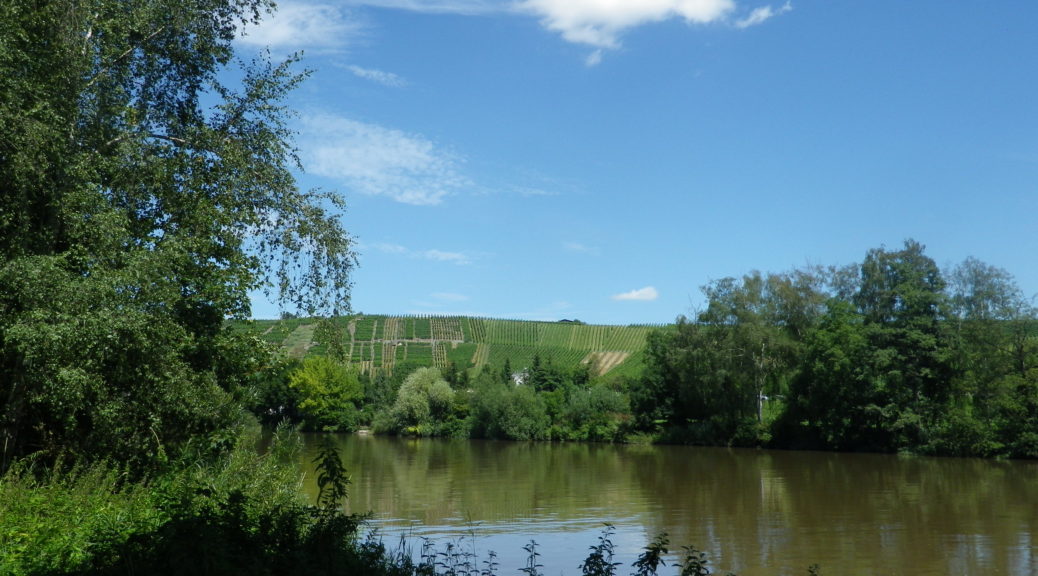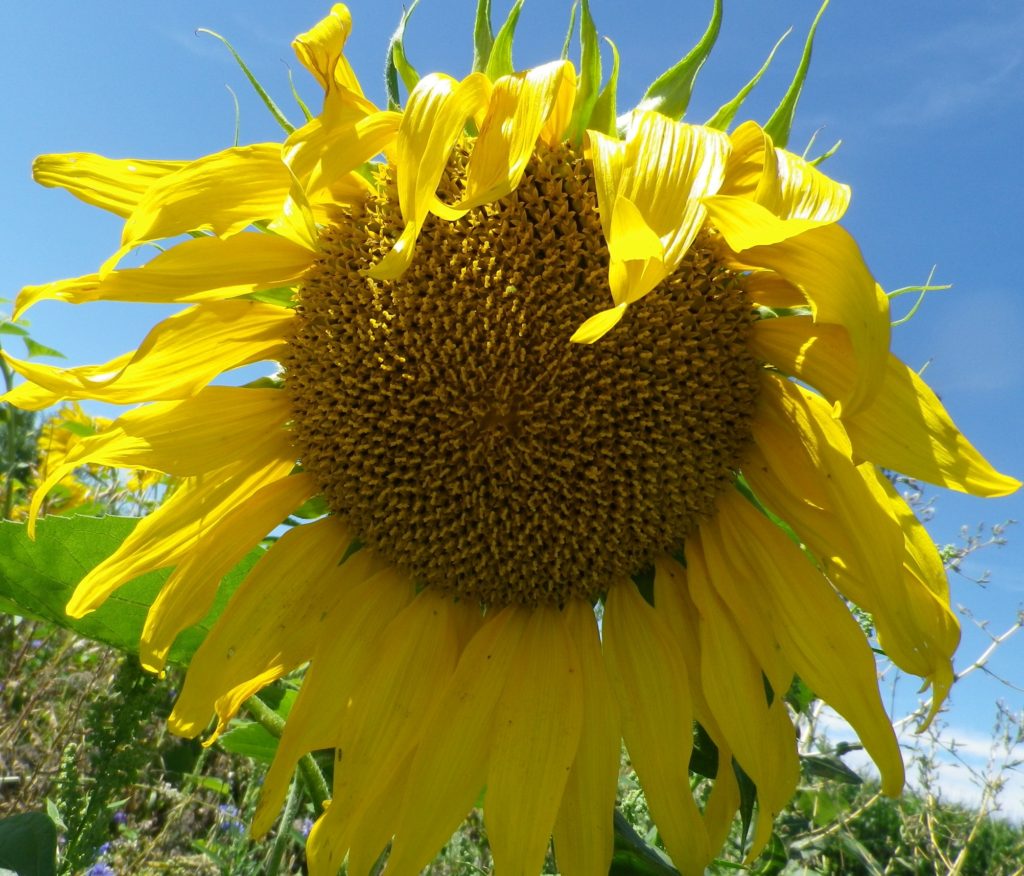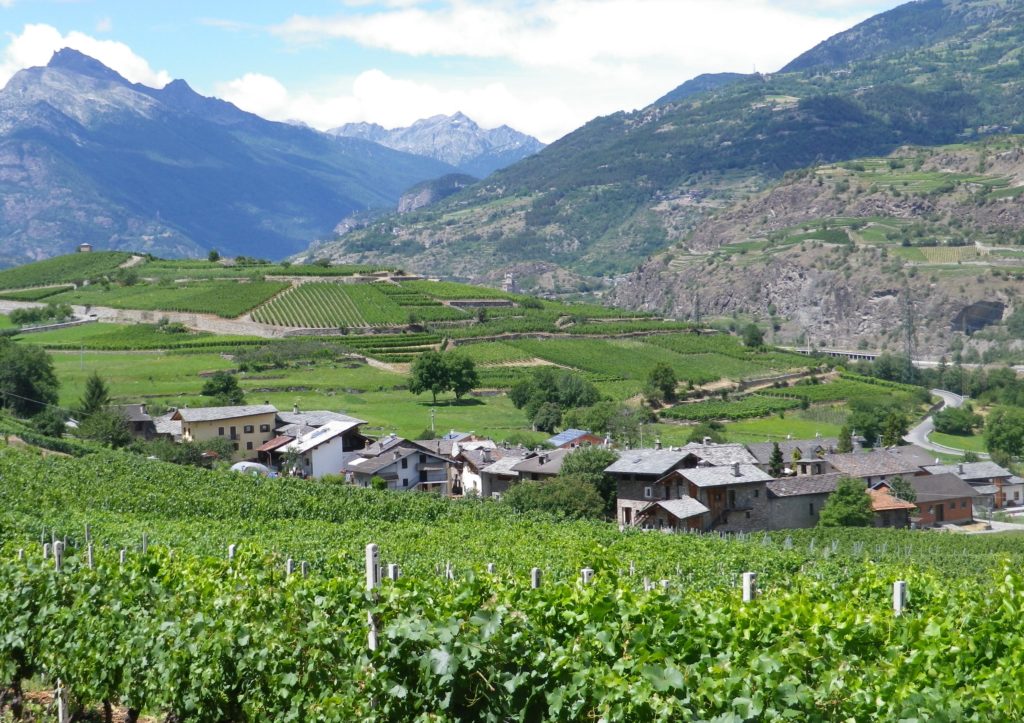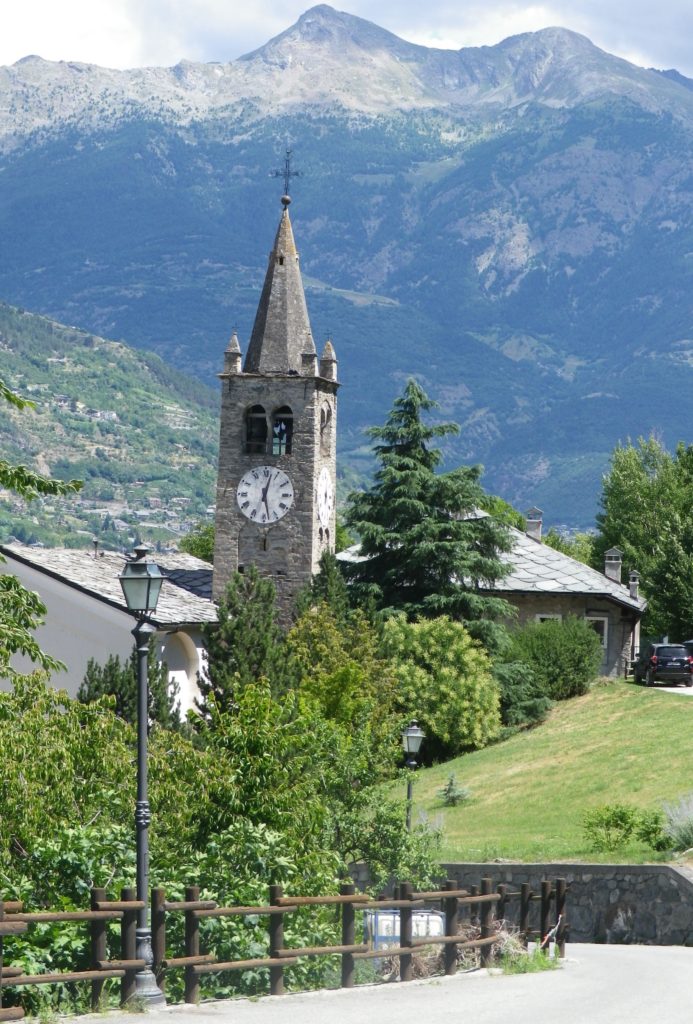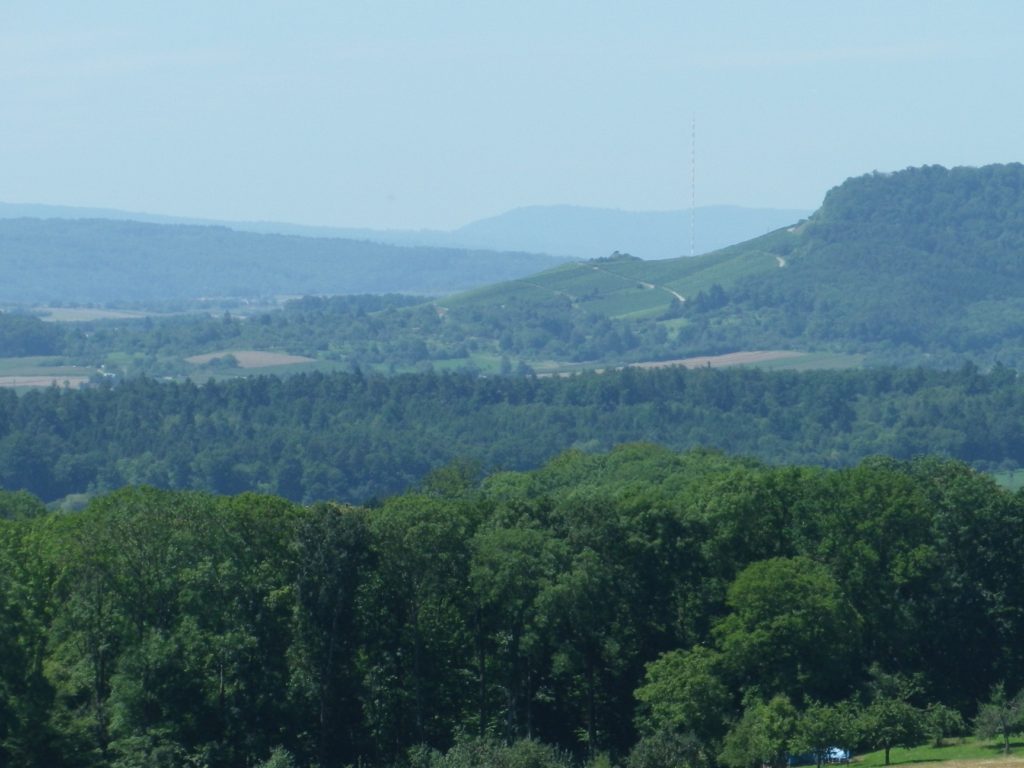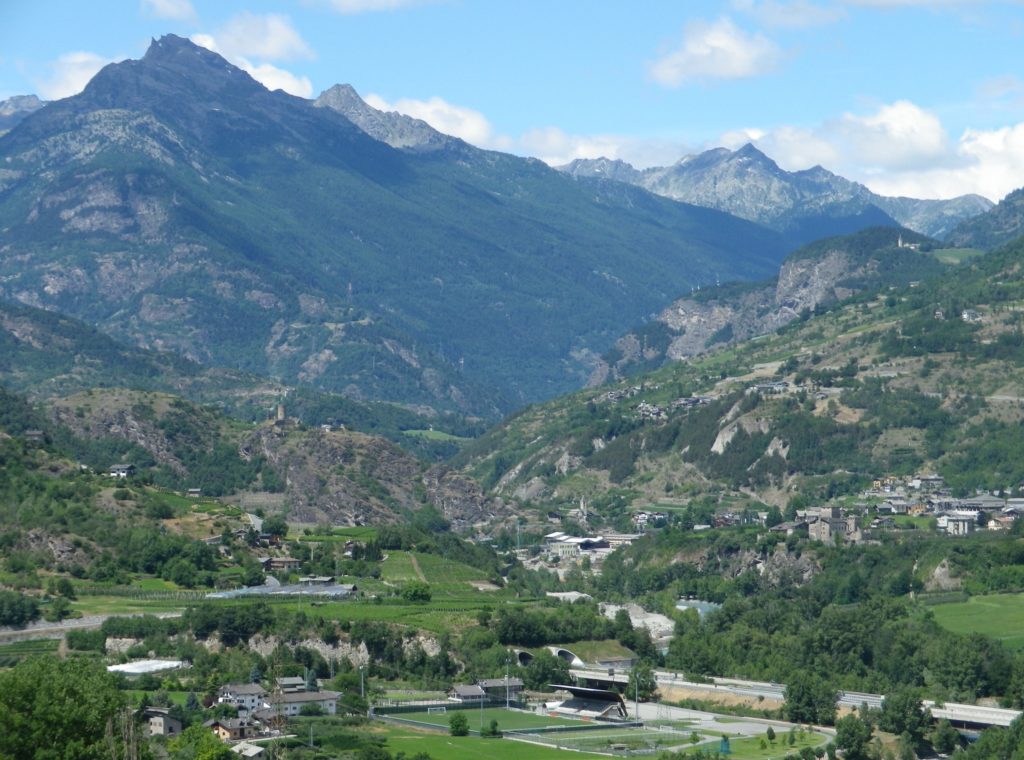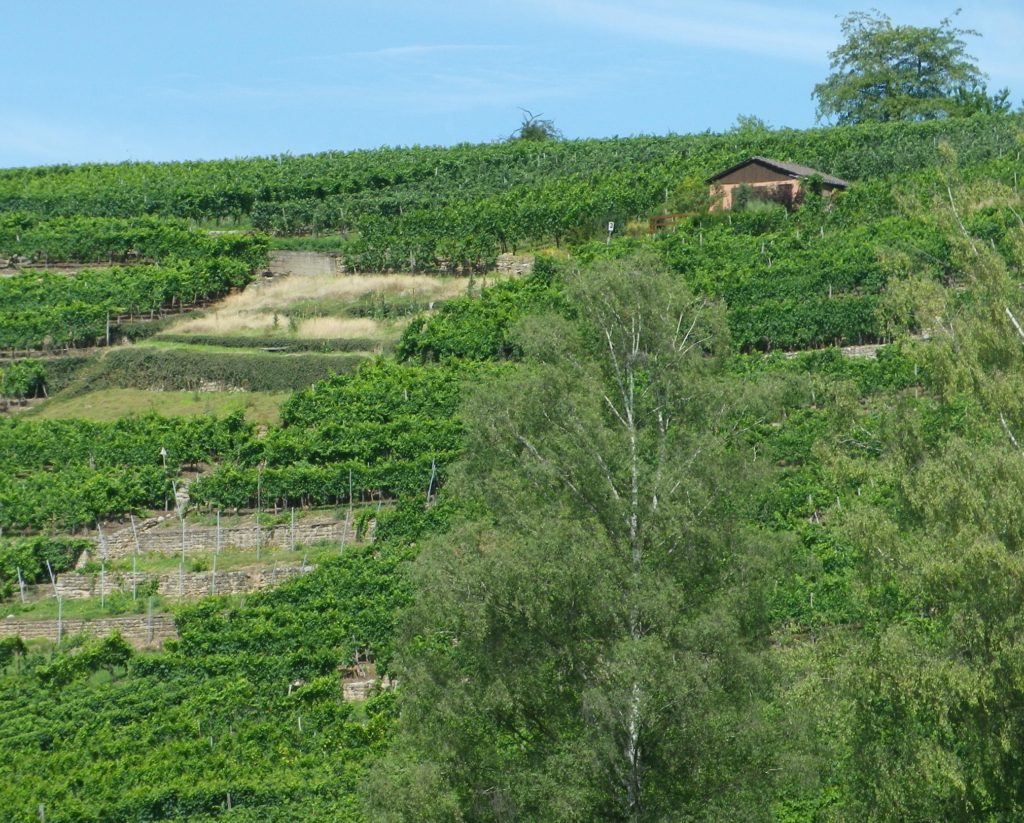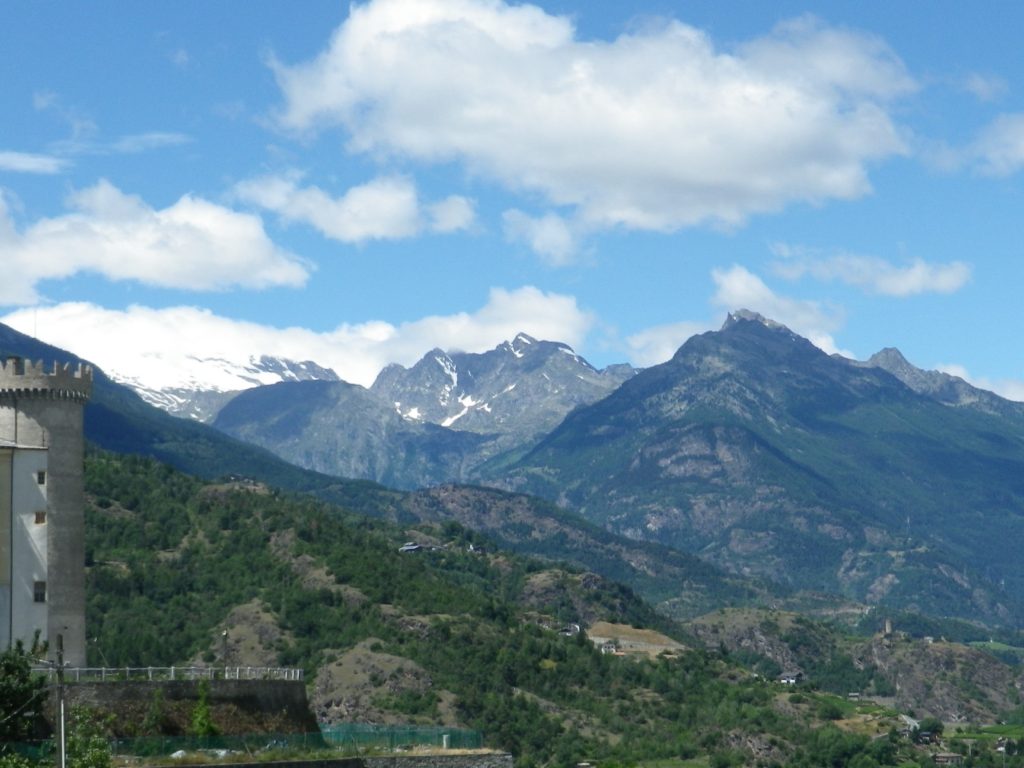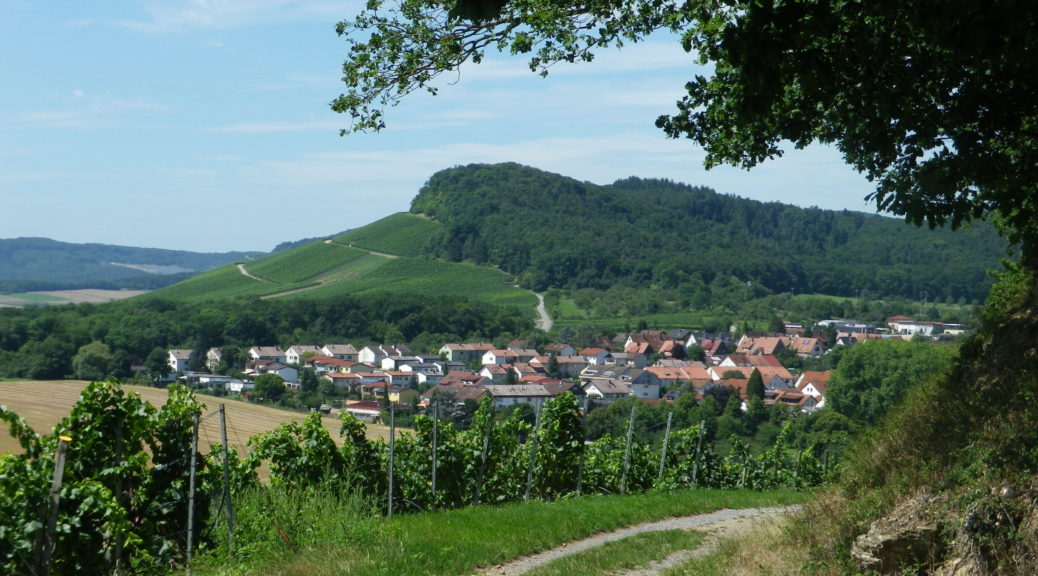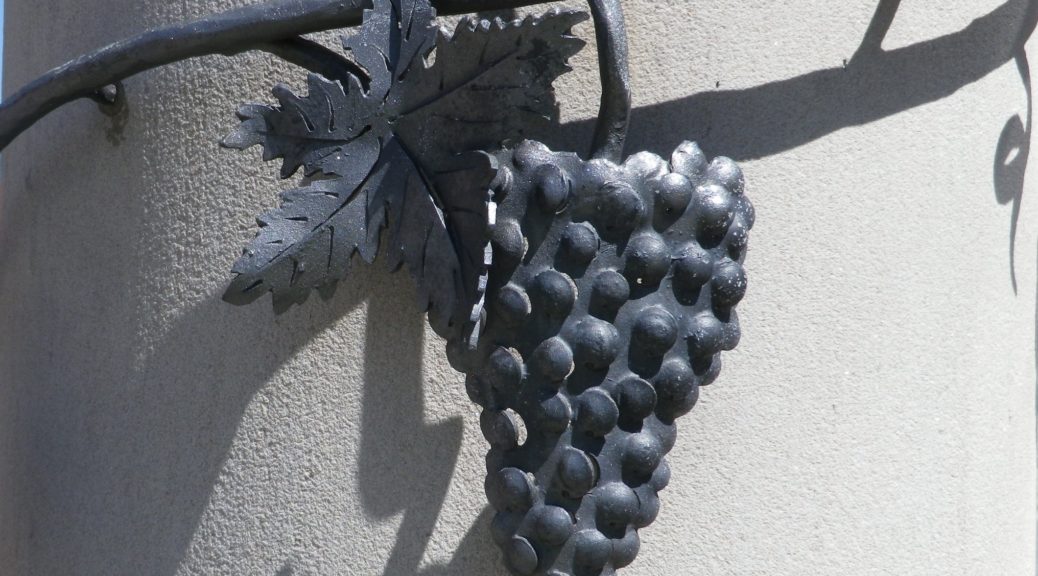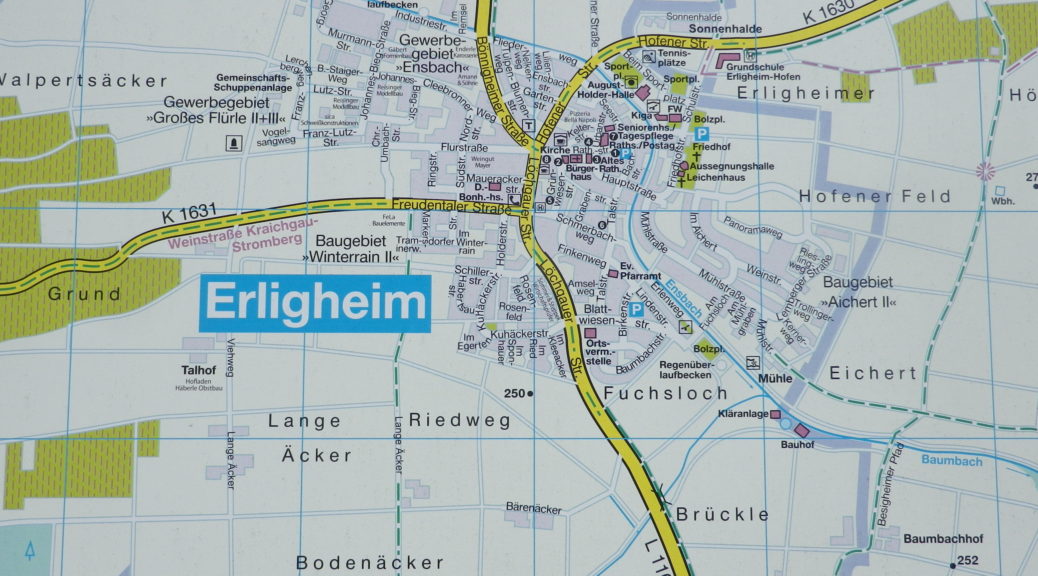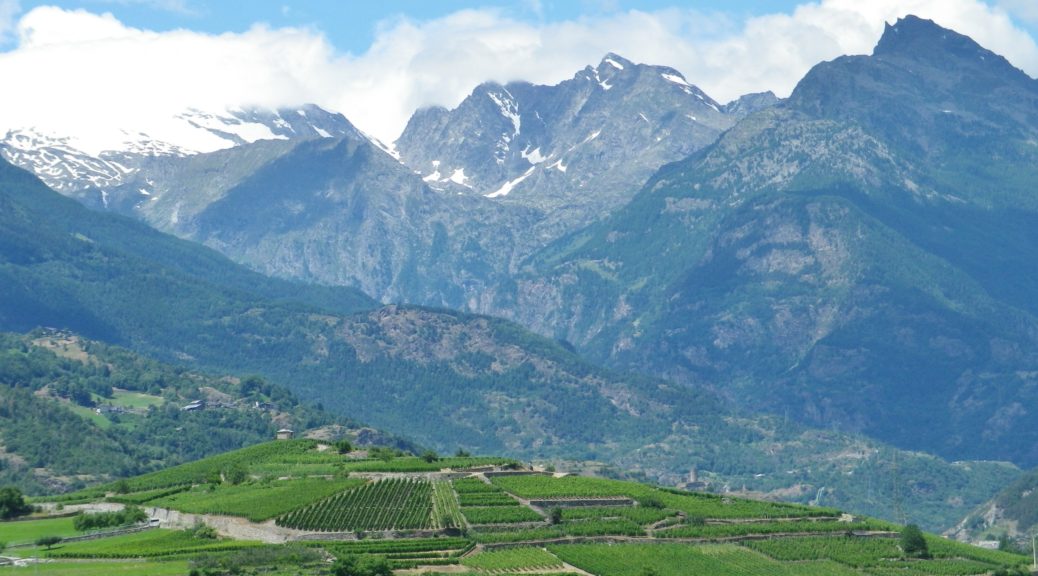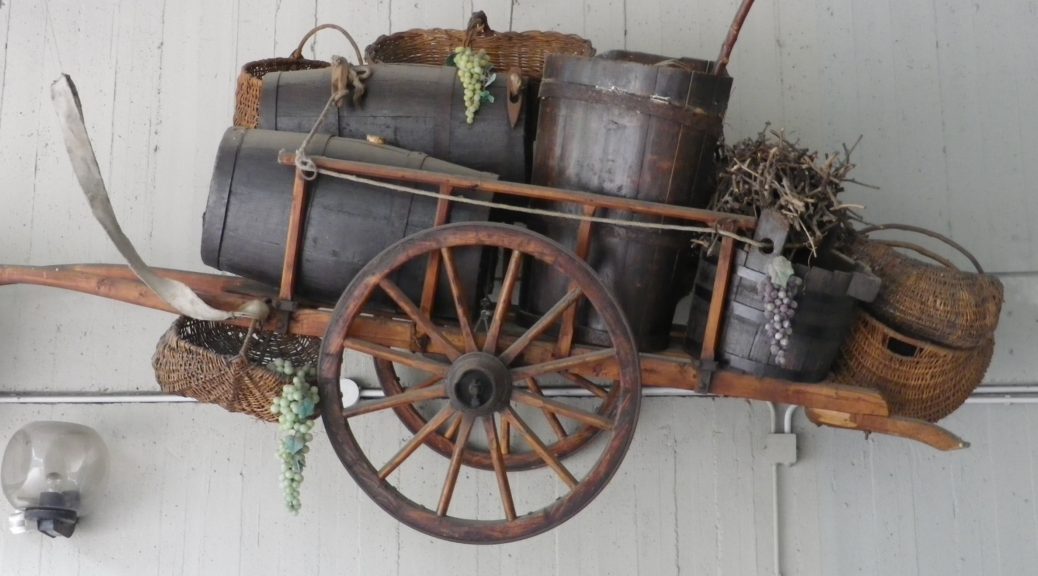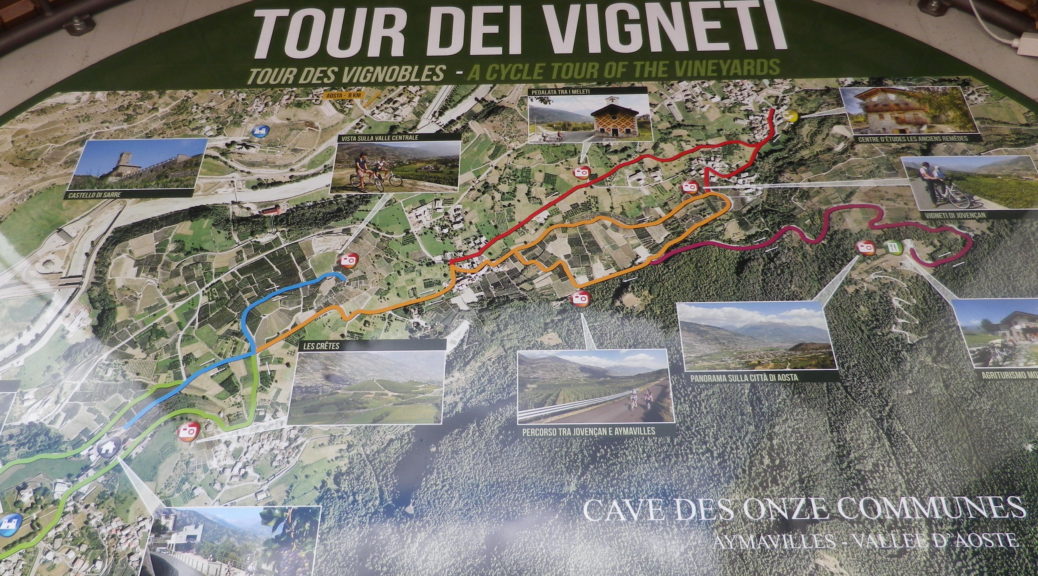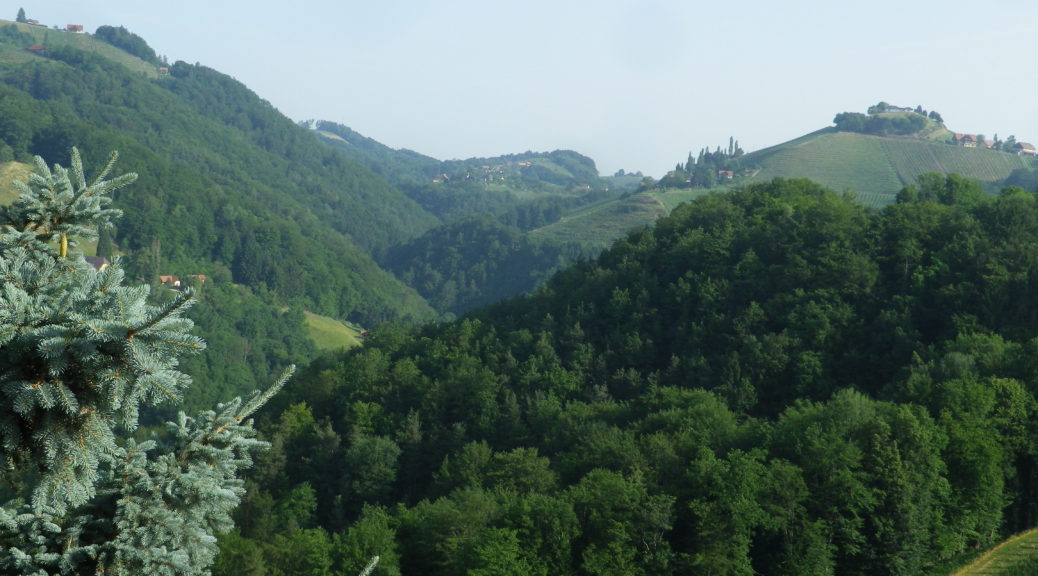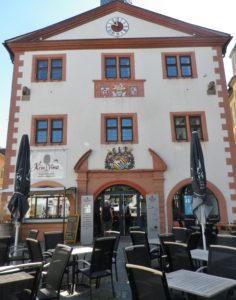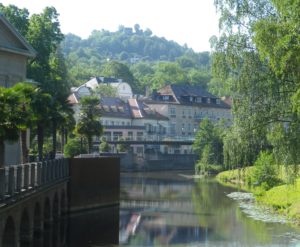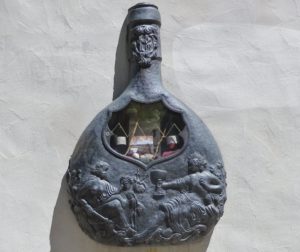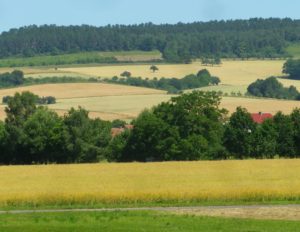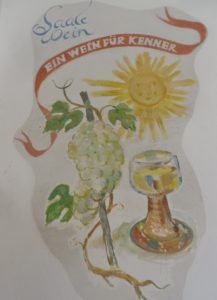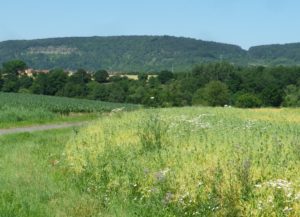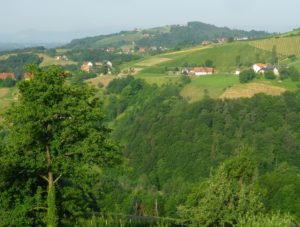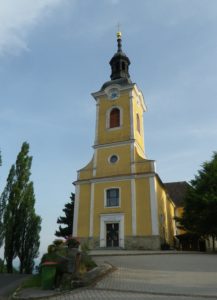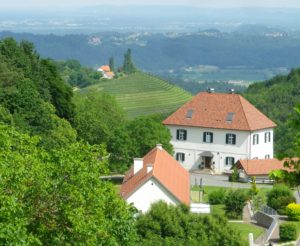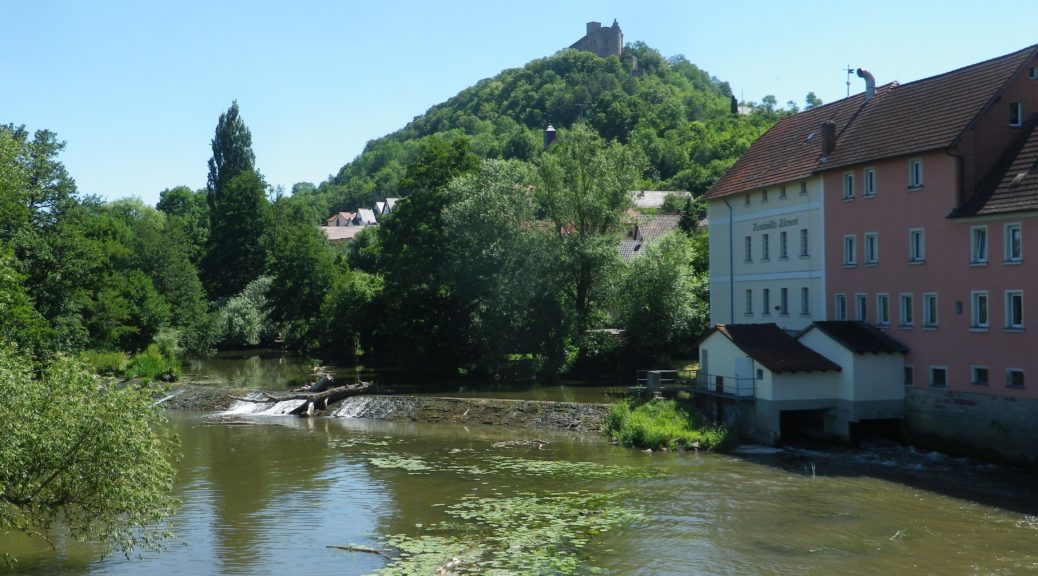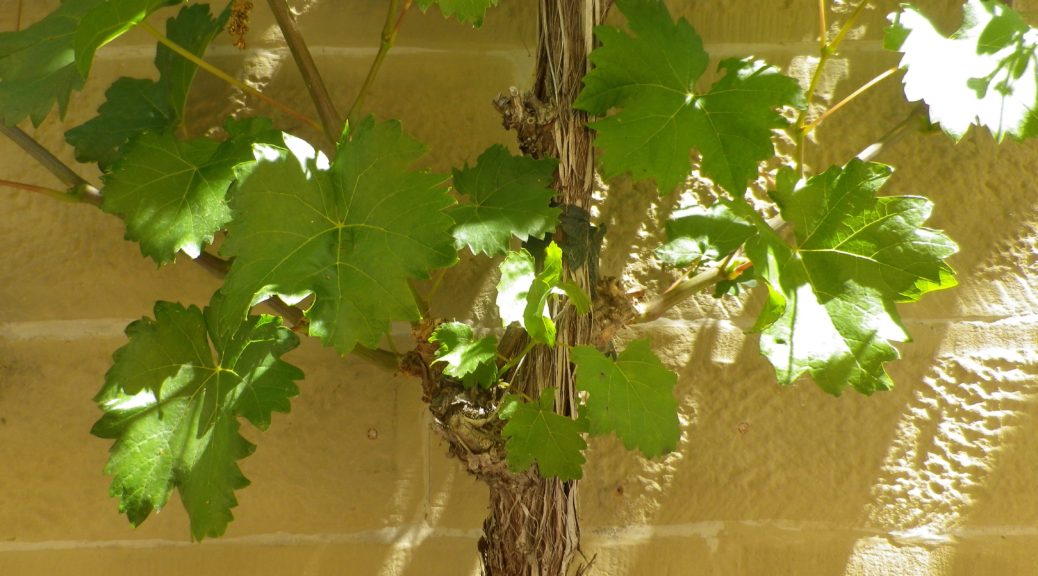A Fruitful Journey
In the Swabian hinterlands, both fruits of the vine and tree are made into alcoholic beverages. Both traditions have impressive roots, sometimes literally, dating back centuries, if not millennia. So, it was with great enthusiasm that I set off to explore this area on the Wein und Obst (Wine and Fruit) Tour.
Famed for both its orchards and vineyards, this idyllic Swabian interlude is located between Heilbronn and Stuttgart, two major cities in Swabia, both set along the Neckar River. Walheim, where the Wein und Obst Tour circuit officially begins, and neighboring Kirchheim am Neckar, where I began the circuit, are both small riverside towns. The trail connecting them followed the Neckar downstream, through shady copses, along the green embankment. It provided an easy warm-up for the rest of this trail.
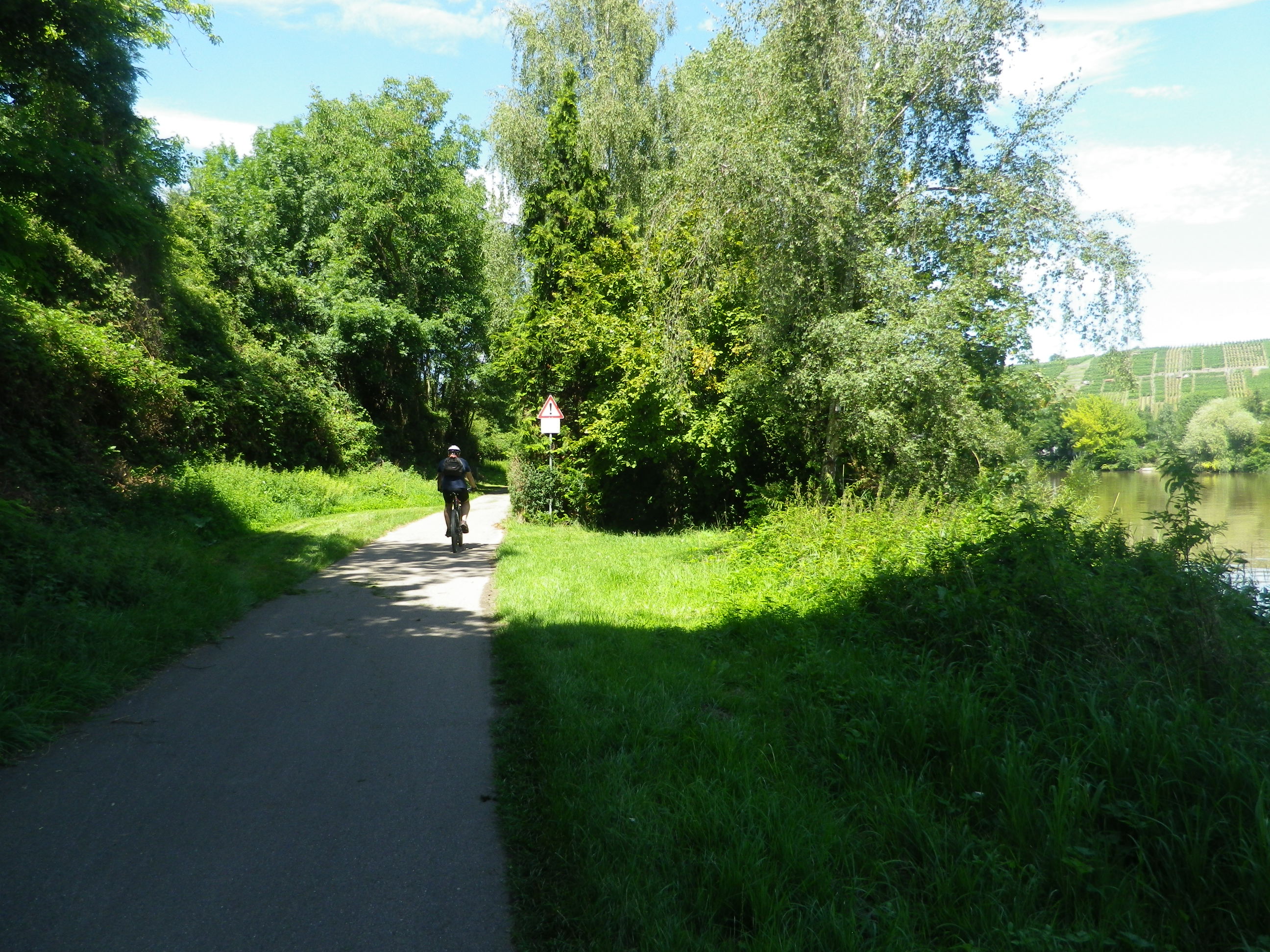
In the gently rising flatlands behind Kirchheim, the first of many orchards came into view. Some of this fruit would be made into “Schnaps” an alcoholic drink with fruit must or flavor. Apple schnapps, pear schnapps, plum schnapps, apricot schnapps, cherry schnapps, and I am sure that is not all. (If it is a fruit, somebody has undoubtedly made it into an adult beverage at some point.) So devoted are the Swabians to these local specialties, that nearby Boennigheim is home to the Swabian Schnaps museum.
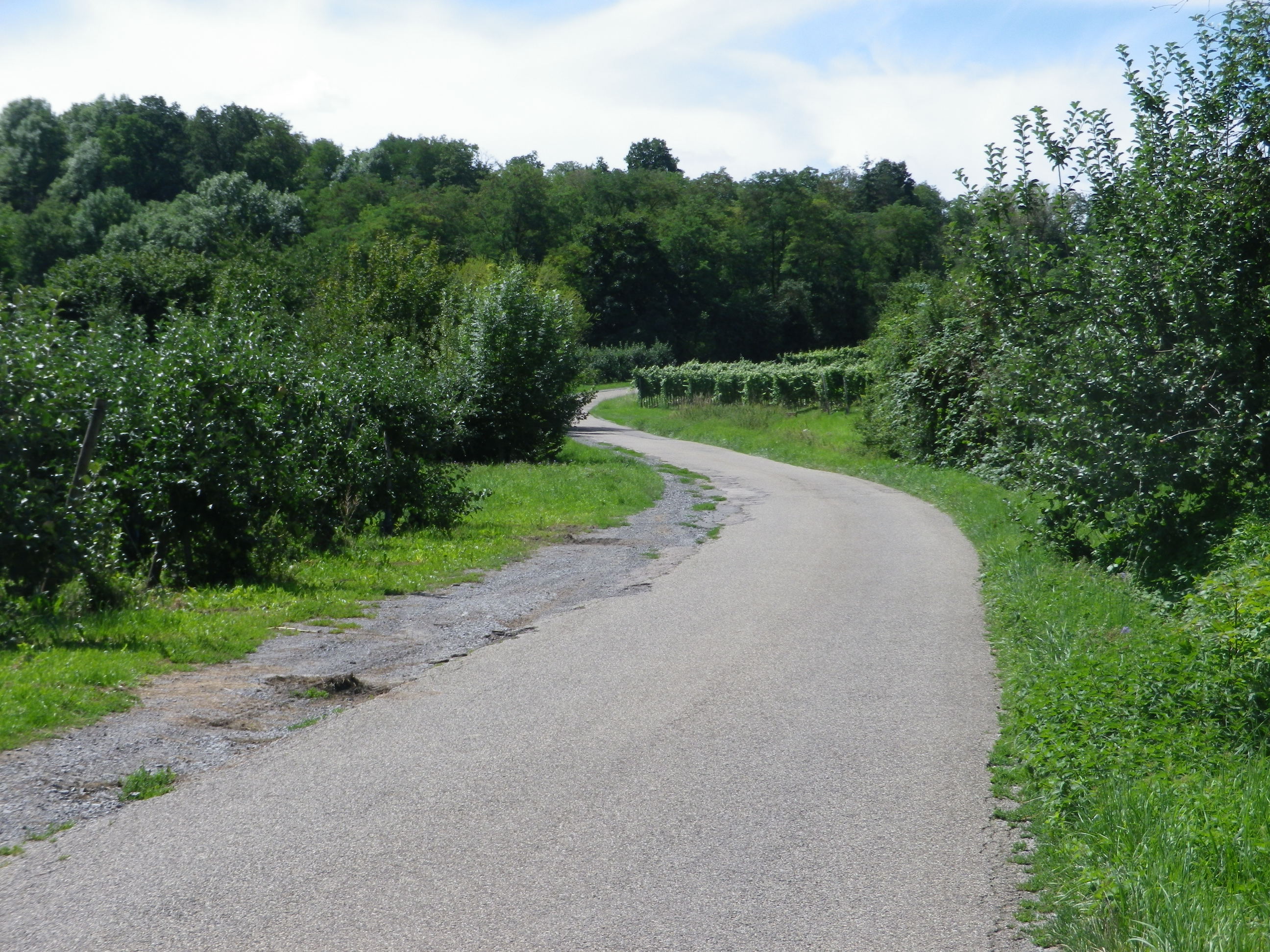
But the other passion in Swabia is wine. As the hills rose higher, I began to cycle through vineyards. The trail meandered along slopes with views of distant mountains crowned by forests, and fields of grain on lower terrain. Up hills, and down, all along accompanied by the delightful scent of fruit and pine trees.
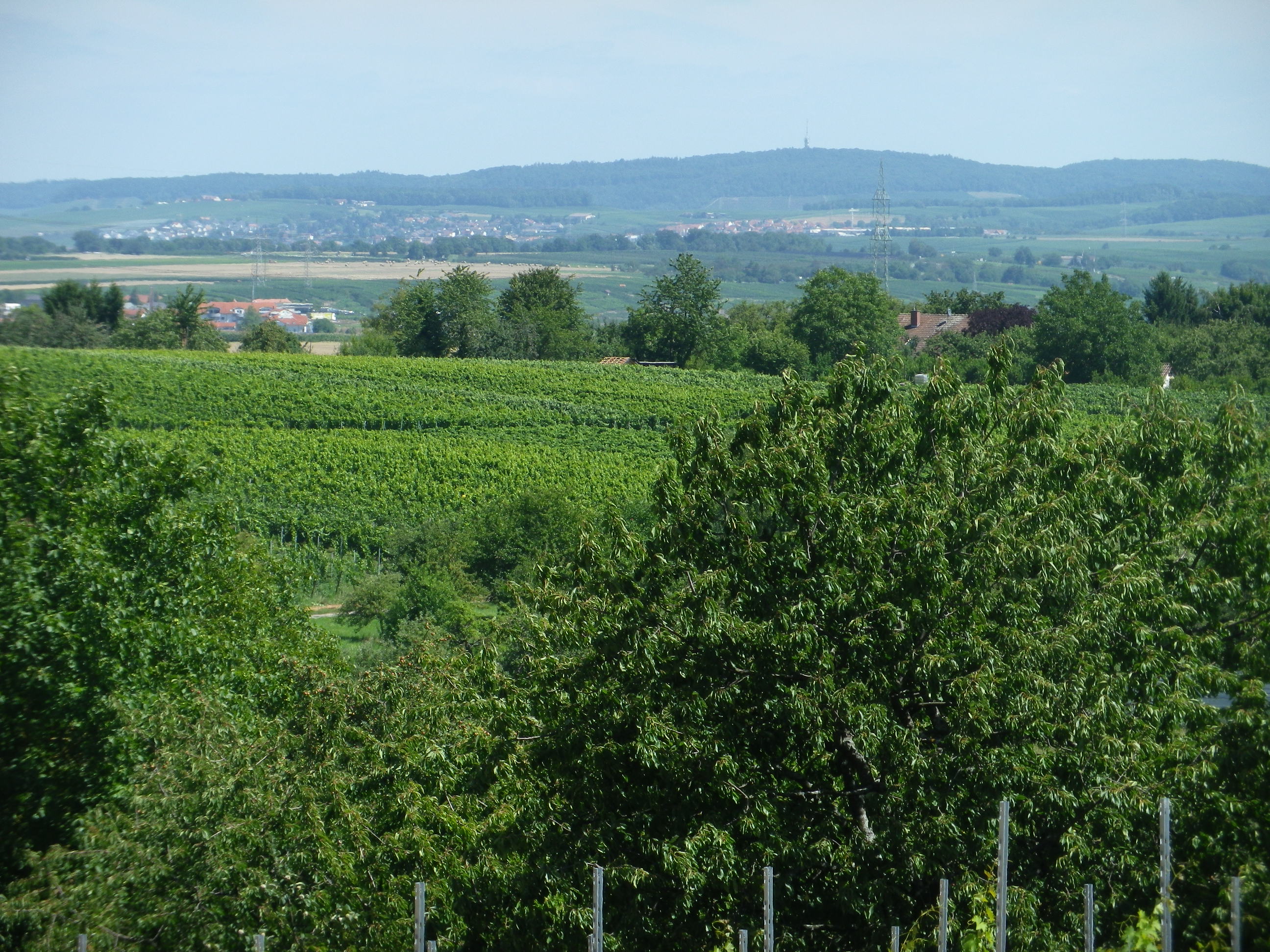
Almost not a car in sight until I reached the village of Freudental. The name literally means Joy Valley, and I can see why, surrounded as it is by orchards and vineyards, in a tranquil nook where even the king of Wuerttemberg enjoyed summers here in a “small” getaway palace. A village wine festival was in full swing as I cycled through, spreading more joy as time and wine flowed on.
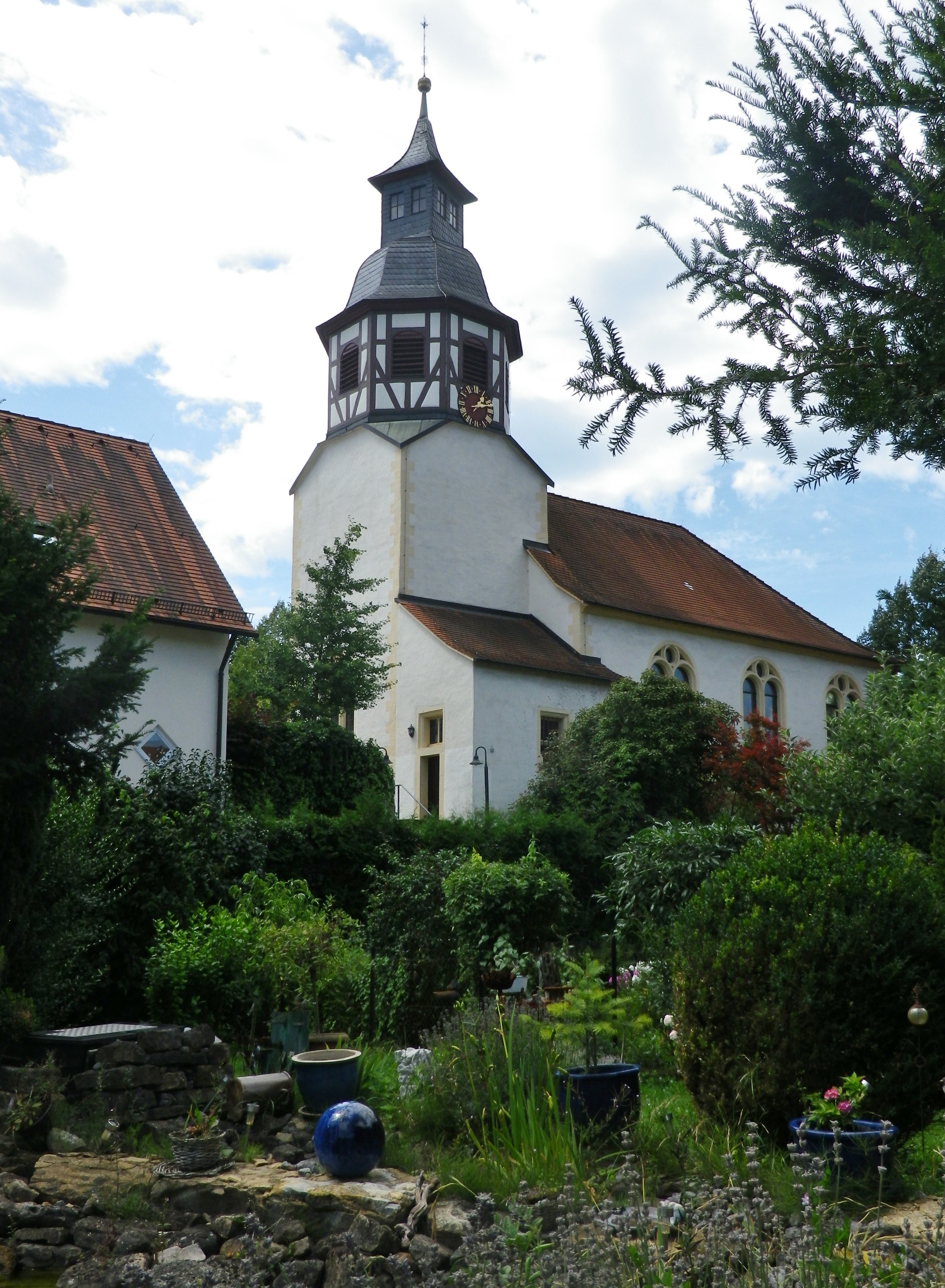
Once through Loechgau, the trail finally led downhill, along a trail as well-maintained as it was aesthetically pleasing, passing through vineyards, woods, and orchards along a quiet stream, all the way back to Walheim, where sampling the local beverages is more easily said than done! (Tip: Take your own to the Schoenste Weinsicht Besigheim, at Auf der Burg in Walheim.) While no wine or schnapps was to be had on this August Sunday afternoon, I certainly had my fill of vines and orchards on this delightful local trail.
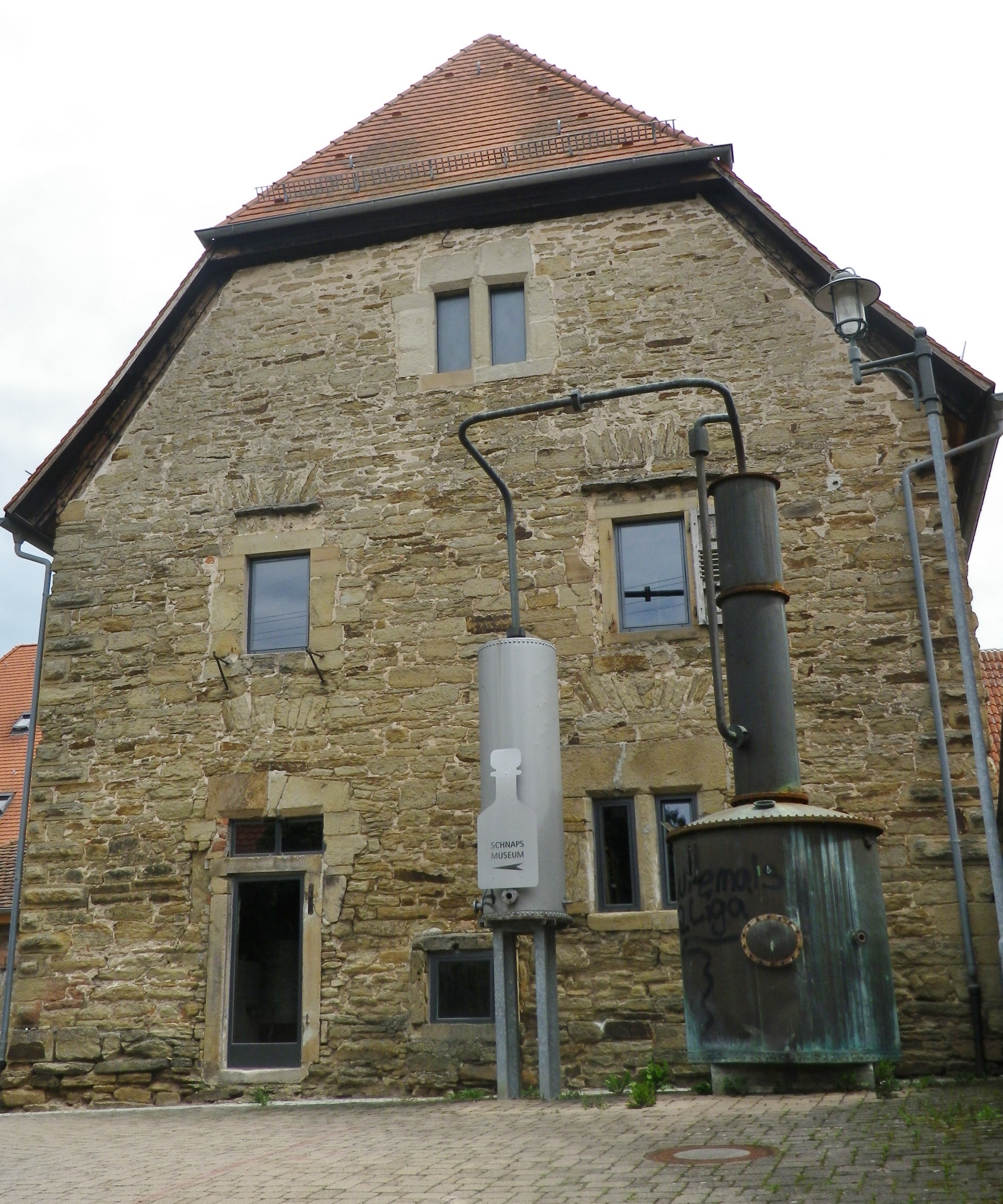
Wine Notes: Wuerttemberg’s Stromberg
What I Learned
Wuerttemberg is a large and diverse wine region in Germany. It stretches from the north at Bad Mergentheim (only 25 miles south of Wuerzburg) then south to Lake Constance; from the east by Lindau, to the west, just north of Pforzheim. It has several main districts, (Bereich Kocher-Jagst-Tauber; Wuerttembergisch Unterland; Bereich Remstal-Stuttgart; Bereich Obere Neckar and two small areas on the Bodensee (Lake Constance), one part of which is technically in the German state of Bavaria). Within a couple of these districts, several major growing zones exist.
Throughout this south-central German region red varietals tend to predominate. Most people are surprised to learn that, given that Germany is famous for its Riesling wines. But more surprising to me, given the region’s climate, is that red varietals do especially well here. In fact, several varietals are almost unique to this region, in that they can’t easily be found elsewhere in Germany, or even the world. These include the Lemberger and the Trollinger varietals. The light Trollinger is a special Swabian favorite in the summer, when it is often served slightly chilled. But on the other hand, it is also often blended with Lemberger, a heartier red wine. Two other varietals, both hearty reds, include Dornfelder and Acolon (my personal favorite), both developed at the nearby State Education and Research Institute for Viticulture and Pomology (Staatliche Lehr- und Versuchsanstalt für Wein- und Obstbau) in Weinsberg, just outside Heilbronn.
Wuerttembergisch Unterland is the name of the wine district north of Stuttgart and the Rems River. It includes Marbach and Benningen facing each other on opposite sides of the Neckar. Then Hoheneck (part of Ludwigsburg) and its counterparts on the opposite shore, Neckarweiher and Poppenweiler. The northern part of this district reaches Heilbronn’s northern suburbs.
This post covers a small zone in the middle of the Wuerttembergisch Unterland district, the Stromberg wine zone. Located south of Heilbronn, and west of the Neckar, dominated by the Stromberg mountain range, which combined with the Heuchelberg mountain range, (yet another wine zone in the Wuerttembergisch Unterland), forms an extensive nature park. Not surprisingly, both the Stromberg and the Heuchelberg zones are in the area known as the land of 1000 hills. The hills are perfect for planting vineyards!
Kirchheim am Neckar, Erligheim, Bonnigheim, Freudental, Loechgau, Hofen, Ochsenbach, Guendelbach, Horrheim, Hohenhaslach, and south to the Enz River, form part of the Stromberg zone. This area is distinct from some of the vineyards directly on the Neckar River, such as in parts of Walheim. Being further away from the river results in a slightly cooler climate in the winter, and warmer in the summer. Some of the locally renowned named vineyard parcels include the Kirchberg, Sonnenberg, and Lerchenberg.
What I Tasted
2016 Riesling Boennigheimer Sonnenberg, Trocken, QbA, Weingaertner Stromberg Zabergaeu (Boennigheim): A dry white wine with medium minus gold color; nose of spice, floral, grass, and slightly fruity, with spice, floral and grass flavors; a medium plus acidity with a tart finish.
2016 Riesling, Trocken, Weingut Mayer (Erligheim): A dry white wine with medium plus gold color, green grape, chalk and slight citrus nose, with grape, spice, and slight gooseberry flavors; medium acidity, with a crisp finish.
2016 Lemberger, Spaetlese, Qualitaetswein, Trocken, Weingut Funk, (Loechgau): A dry red wine with medium ruby color; honeysuckle, and dried cherry nose with a hint of tobacco, with vanilla, honey, floral, and red berry flavors; medium tannins.
2015 Lemberger, Boennigheimer Sonnenberg, Trocken, Deutscher Qualitaetswein, Weingaertner Stromberg Zabergaeu: A dry red wine with dark garnet color; cherry, and green wood on the nose, with sweet cherry, vanilla, and vegetal flavors; medium tannins.
2014 Regent, Spaetlese, Trocken, Weingut Mayer (Erligheim): A dry red wine with dark garnet color; jammy grape, and brioche nose, with ripe grape, smoke and vanilla flavors, medium minus tannins, very smooth
Wein und Obst Tour: Trail in a Nutshell
Trail Name: Wein und Obst Tour (Wine and Fruit Tour)
Trail Type: Medium distance cycling circuit; much of it paved, well maintained in all but a couple of very small sections, good trail signage along most of the way.
Length: Total: 25.5 kilometers/16 miles
Convenient to: Ludwigsburg, or Heilbronn, Germany
Marking: Blue lettering “Wein und Obst Tour”
Trail Description: A well laid-out cycling itinerary up and away from the Neckar River, while mostly on dedicated bike paths (or farming access lanes) through a variety of agricultural landscapes, as well as towns and villages. While not difficult, there are some hills, and a couple of long, unshaded stretches of trail, as well as the schnapps to watch out for!
Trailhead:
Official: Walheim: Intersection of Besigheimerstrasse and Hauptstrasse
Mine: Kirchheim am Neckar: Hohensteinerstr (by the sports fields)
Parking:
Kirchheim am Neckar: Ludwig-Jahn-Str x Brunnenstr (Gemeindehalle) (Check for hours) or Ludwig-Jahn-Str x Hohensteinerstr (Sports field)
Erligheim: Schulstr (sports field)
Public Transportation Options:
Bus: Some towns are served by the Stuttgart RegioBus line, with regular service to Loechgau or Kirchheim am Neckar.
Rail: DeutscheBahn regional trains (Stuttgart to Heilbronn and vice versus) serve both Kirchheim and Walheim with several convenient options every day.
Suggested Stages: Not applicable
Trail Itinerary-Reference Points:
Walheim: Haupstr-Heilbronnerstr, path along west side, then a specific crossing point to east side of tracks; follow along the river; Kirchheim am Neckar: Am Neckar, underpass, Hauptstr-Rathausstr, Bachmuehlweg-Talstr-path through fields; Hohenstein: Feldbrueckenstr-Kirchwiesenstr-Muehlstr-Mittlerestr, path to Hoffen: Neubergstr-Gutenbergstr, Sonnenhalde; Erligheim: Schulstr-Friedhofstr-Hauptstr-Talstr, Kuhaeckerstr, path (past Ferienwohnung am Weinberg, Habertsaustr (path), through woods; Freudental: Wolfsbergweg, Seestr, Kirchstr, Bietigheimerstr, path to Loechgau: Friedhofstr-Mauerstr-Grabenstr, Nonnengasse-Hauptstr, past the church, Neuestr-Kelterstr; fields and orchard paths past Baumbachhof, path along Baumbach creek; Walheim: Im der Eichhalde-Weinstr, Im Haiglen-Karlstr, rail underpass
Representative Trail Photos:
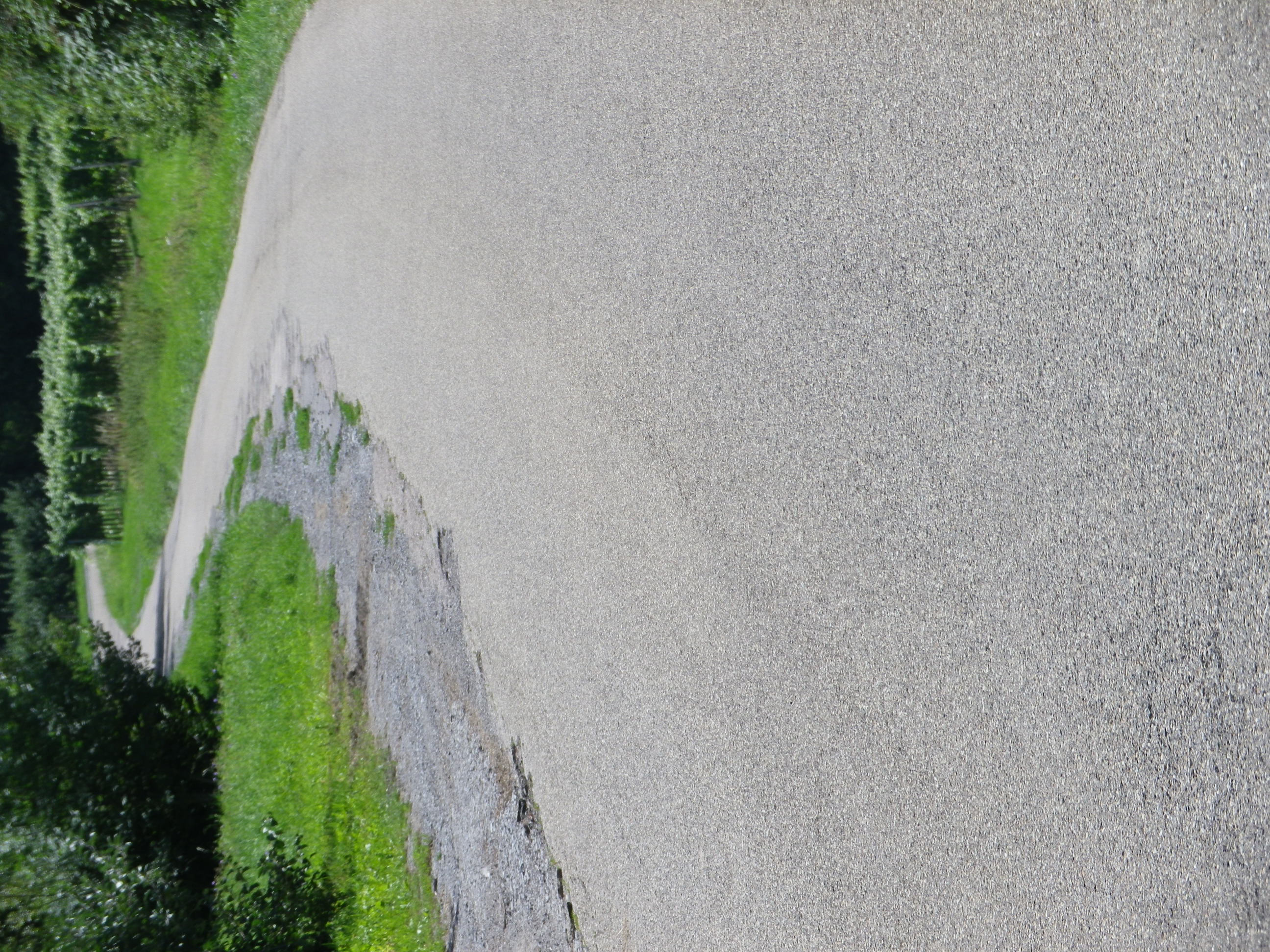
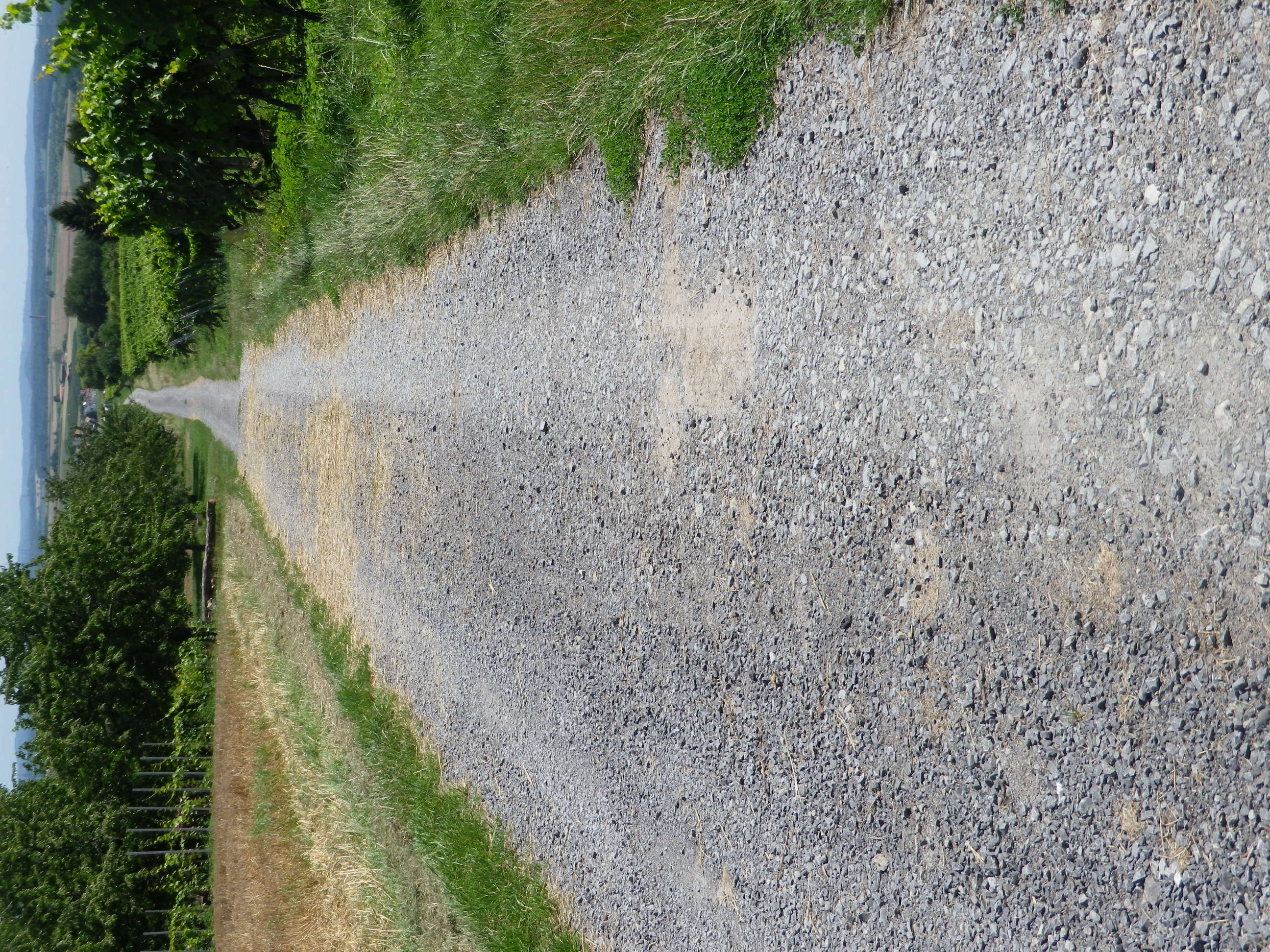
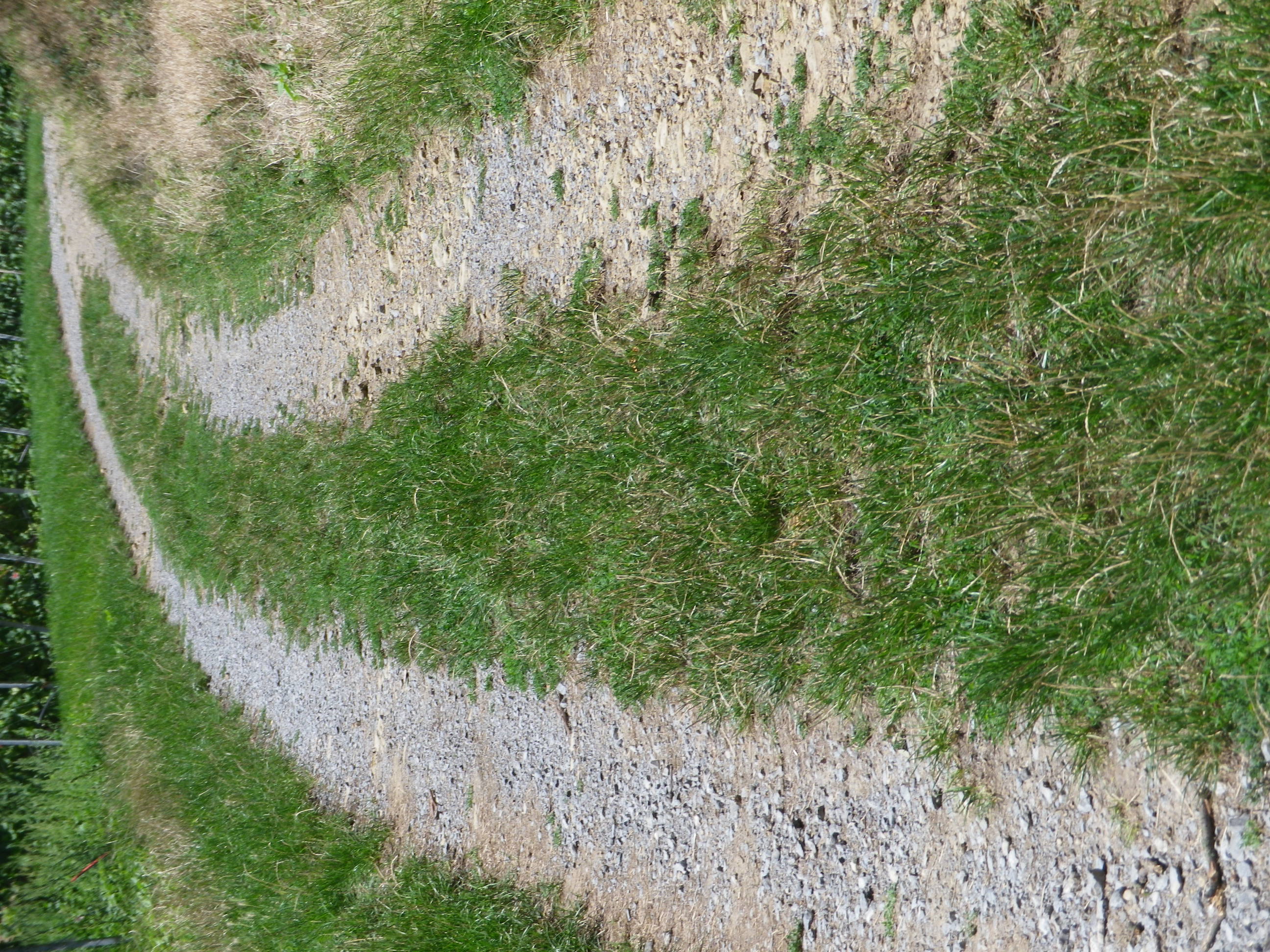
Restrooms:
None observed!
Attractions on or near Trail:
Museum in der Stiftsscheuer, in nearby Mundelsheim, provides information about local viticulture, as well as other topics.
Several viewing areas are set up throughout the region to provide great scenic panoramas over the vines, and distant countryside, the closest to the trail being the Schoenste Weinsicht Besigheim, in Walheim.
While not wine related, the Schnaps Museum in Boennigheim, displays information about the alcoholic fruit beverage of schnapps.
Tasting along the Trail:
The WG Strombg Zabergau regional winery has an outlet in Boennigheim, and is a good place to obtain bottles of some of the regionally renowned named vineyard parcels such as Kirch-, Sonnen-, Lerchen- berg. While Erligheim has several individual family wineries such as Weinbau Reichert; Weingut Baehr; Weingut Schifferer and Weingut Mayer.
Alternative Options:
Hiking: From nearby Besigheim, hikers may choose one of a couple of half-day circuits developed by the Felsengartenkellerei (a local winery), with downloadable maps at https://www.felsengartenkellerei.de/credo.html . See a Nutshell of one of them here.
Biking:
The 96.4 kilometers (64 miles) Wuerttemberger Weinradweg Variante Stromberg im HeilbronnerLand circuit tour is a much longer, and more challenging tour through the towns and nature park area of Stromberg-Heuchelberg.
The 29 kilometer Land-Wein tour is a circuit tour beginning just south of Walheim in the picturesque town of Besigheim, follwong along and crossing the Neckar River a couple of times. It shares some of the Wein und Obst Tour itinerary in the flatter areas. (See the Marking photo above.)
Car: The Wuerttembergische Weinstrasse car touring itinerary covers this territory, and more. The shorter Kraichgau-Stromberg Weinstrasse car touring itinerary covers a smaller district, heading primarily west from Erligheim. See featured photo above.
Additional Information:
Regional: https://www.3b-tourismus.de/ (The 3B stands for the three regional centers of Boennigheim, Besigheim and Bietigheim-Bissingen.)
Trail (segment) specific:
https://www.tourismus-bw.de/Media/Touren/Kraichgau-Stromberg-Wein-Obst-Tour
Comments:
A pleasant, half-day excursion, if you find yourself in the Stuttgart region and want to experience unspoilt Swabian countryside!
Days of Discovery in Aosta
Recently, I visited a quiet corner of Italy. That is almost a contradiction of terms nowadays, and rather difficult to find in the summer. Seeking a refuge from mass tourism, I came across a bike ride through vineyards in Aosta Valley. Since I had never been there, I decided to make the trip. What a trove of new discoveries of all sorts!
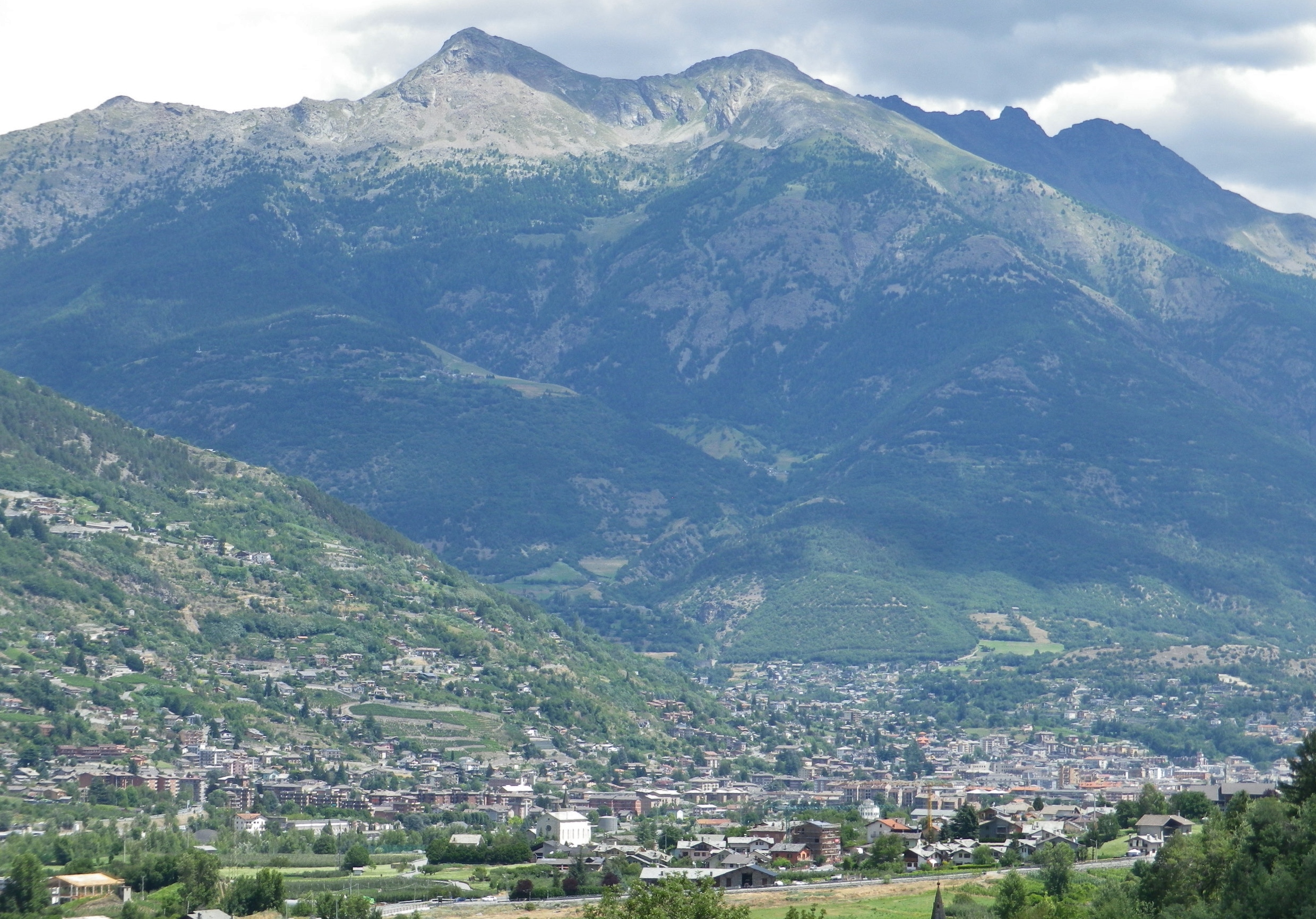
In the first place, the culture is an intriguing mix of French and Italian. Secondly, nature puts on an incredible display of the compelling and pristine: from dramatic Alpine peaks, to well-preserved meadows, to clear, roaring streams. Then, there was the food, and of course the wines.
Personally, I had never seen, or seen offered, a bottle of Aostan wine. But this bike trail was designed to rectify that. There was a clear nexus between the trail design and promotion of the local wine. The trail was designed and promoted by the local wine cooperative, the Cave des Onze Communes, in the heart of Aymavilles, a small Aostan town clinging to a mountainside, dominated by a castle and surrounded by vines.
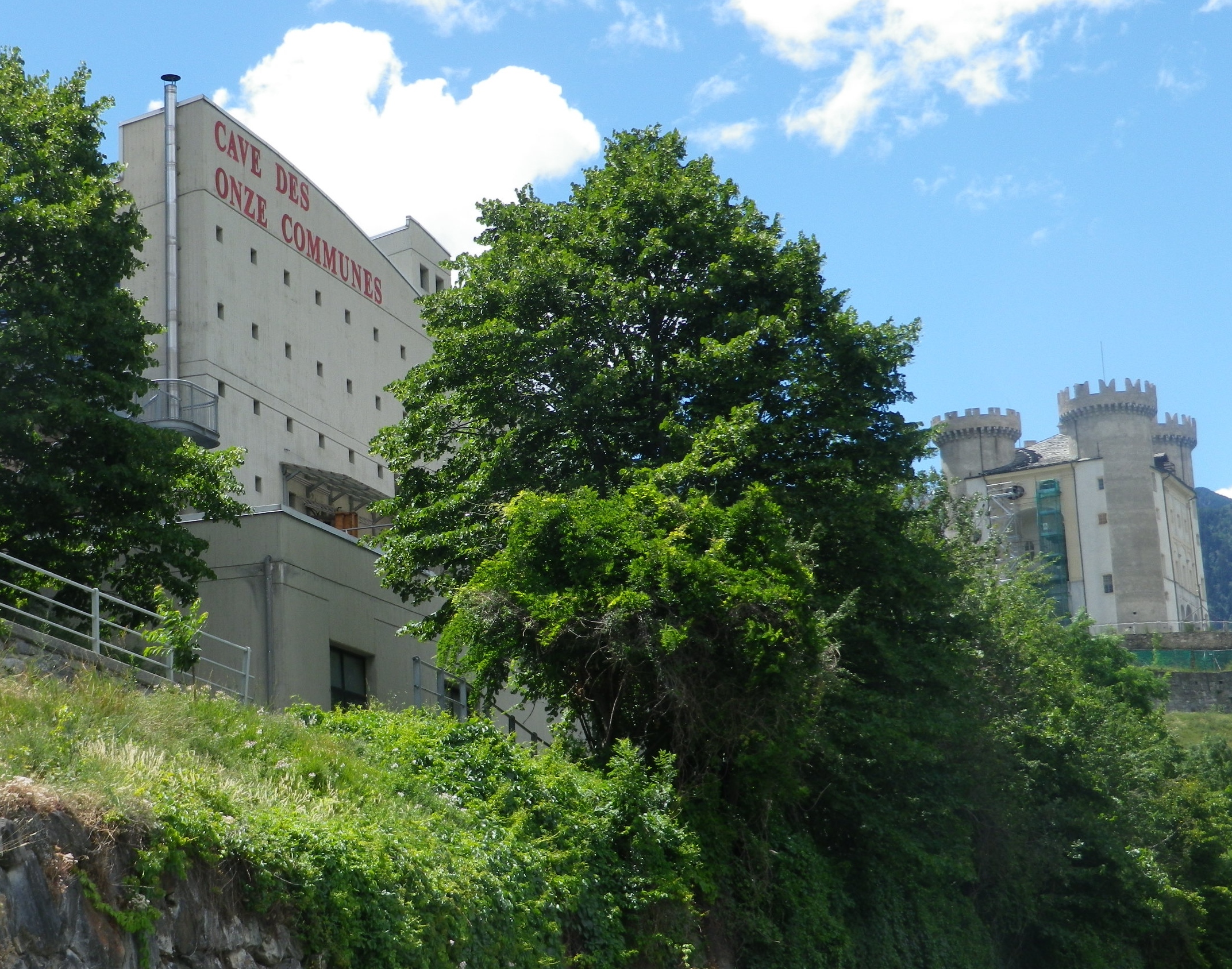
The trail, mostly on low-density/lightly-trafficked roads, either starts at the winery, or near it, or goes around it. There are actually six short segments of trail, three of which radiate from or near the winery. From there, where, and how far to go, is up to the rider.
To lengthen the ride, follow any or all of three other trails which extend from the original three. Circuits and loops may be created, and backtracking to the start is always possible, and in fact mandatory in places. However, at most there are only six miles or so of itinerary to follow, making this ideal for a quick ride.
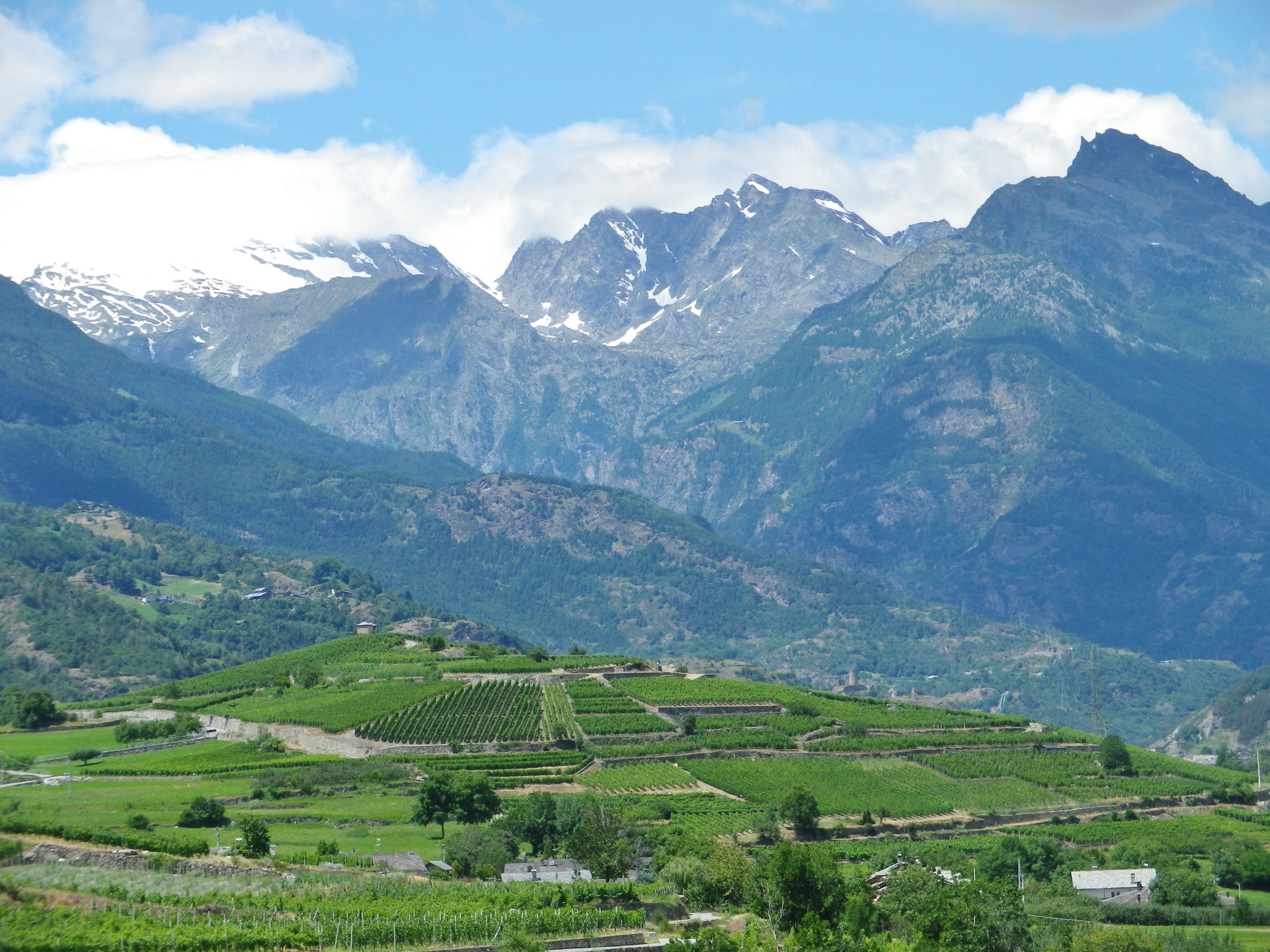
A lovely feature of this trail is the view. Mont Blanc, still topped with snow in July, is visible along part of the way, as is Aosta, the main city, in the opposite direction, further down the valley. The trail passes through vineyards, but also affords views of the vineyards on the other side of the valley. A seeming mirror image of the vineyards through which I cycled, these began low, and rose in a very irregular patchwork of vines to surprising heights on the mountains opposite. Above the vineyards were (mostly) pines, and above the tree line, rocky crags pierced the sky, in a brilliant blue on white contrast. Alternatively, those peaks would occasionally snag a cloud, and remained wreathed for a while in a soft white puff.
Castles were visible now and again, barely registering against the backdrop of such massive mountains. This area was conquered and held by many, from Romans to the House of Savoy, before joining the newly formed Italy in the mid-nineteenth century. However the old churches and houses, with steep rooves and deep overhangs, recall that the worst enemy in this part was, and still can be, the weather.
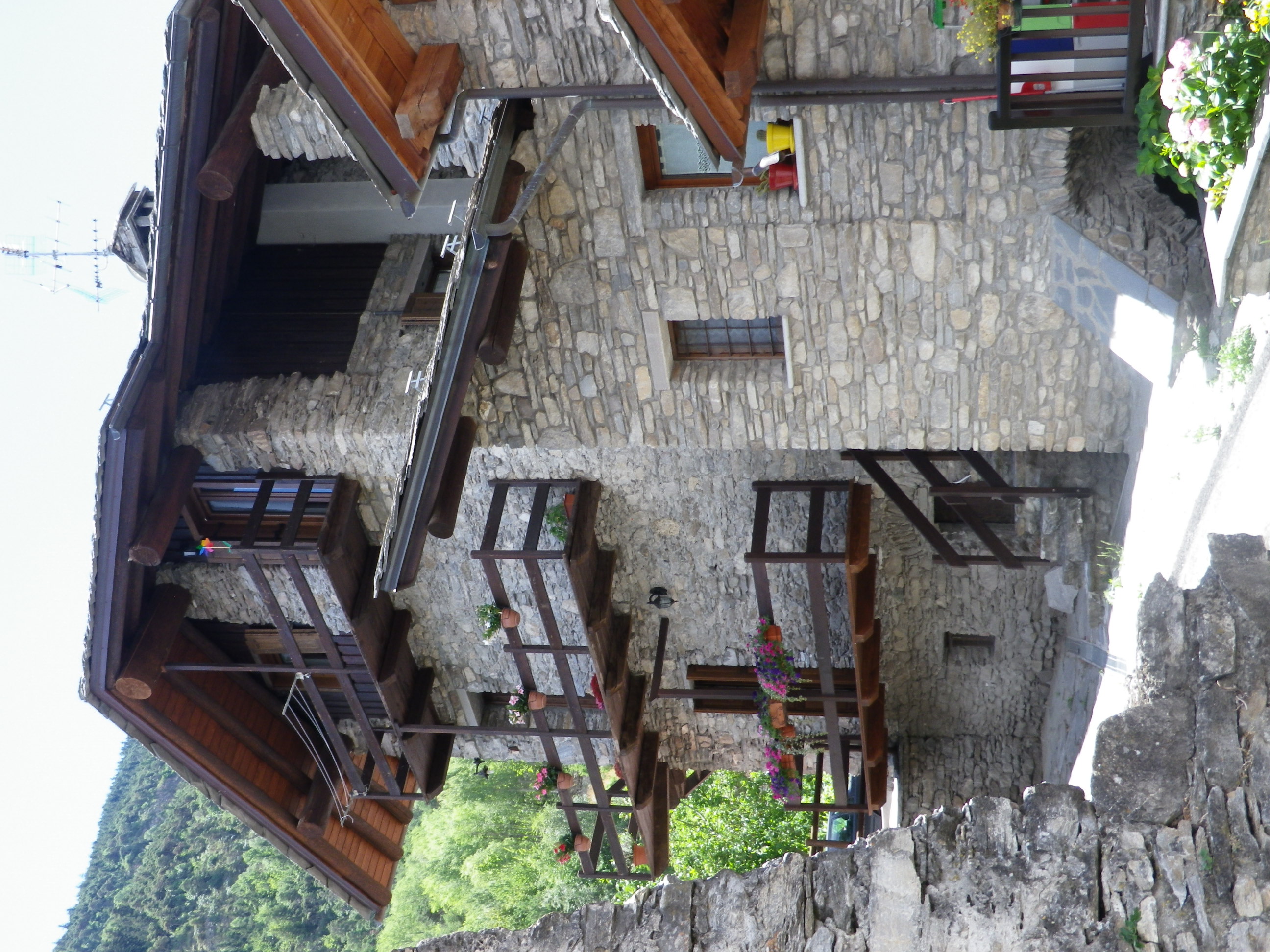
Once back at the winery though, I learned that this area boasts a fair number of local grape varieties, which do well in cold weather, and are more frost-resistant than most. What is more, the varietal wines from the cooperative are delicious, smooth, and quite reasonably priced. Unique grapes and different delicious wines: the best discovery of all!
Wine Notes: Italy’s Val d’Aosta
What I Learned:
Valle d’Aoste (Aosta Valley) is in the northwest corner of Italy, where Italy, France and Franco-phone Switzerland meet. It is an autonomous region with a heavy French influence. This influence, and of course earlier Roman settlement in the region, means that wine and wine production figure heavily in local culture. Being not only in the north, but also at a rather high elevation, wine-making is a challenge. But it is one that local winemakers have accepted, especially those vintners close to the French border, whose vineyards lie at altitudes greater than 1000 meters above sea level. (In fact, these vineyards lying below Mount Blanc (itself over 4800 meters above sea level), claim to include the highest vineyard in Europe.) While there are other contenders to that title elsewhere in Europe, there can be no doubt that Val d’Aosta winemakers work in seriously mountainous terroir.
While winemaking in such mountainous terrain is not commonplace, it is hardly unique. What is unique however may be found in the high number of native grape varieties. Both red and white varietals grow here, and thrive in the local conditions. The paragraphs below list some of the varietals, both red and white, that are native to the Aosta Valley.
The red varietal Fumin is widely cultivated throughout the central part of the Aosta Valley. Judging from the variety of Fumin Aosta DOC wines on offer, this grape produces a popular varietal wine. Cornalin is another local red varietal, which also produces an Aosta DOC varietal wine. Just over the mountains in the Swiss canton of Valais, the same grape is called Humagne Rouge. Italian vintners cultivate this varietal much less extensively than their Swiss counterparts though.
However, the most widely cultivated local varietal is the Petit Rouge in the Aosta Valley. Second place in terms of hectares cultivated goes to the Vien de Nus, a varietal named after its alleged place of origin. A minimum of 70% of Petit Rouge must be present in the Aosta DOC red wine, Torrette. Vien de Nus may be added to a Torrette cuvee, but it is never vinified as a varietal wine.
The early maturing Mayolet, almost extinct, has been rediscovered. It may be vinified as a varietal wine, a rare find, or may be added to the Torrette DOC blend.
In contrast, there is only one white varietal native to the valley. The Prie Blanc, also known as the Blanc de Morgex, is capable of maturing in some of the most elevated Valdostan vineyards. It is, as it would have to be, resistant to frosts and cold. Planted in some of the highest vineyards in Italy, it is not unusual to find that vintners make sparkling and sweet wines with this grape, although varietal wines are also produced.
What I Tasted:
2016 Pinot Gris, Valle d’Aoste Denominazione di Origine Controllata, Cave Gargantua (Gresson): A dry white wine with medium minus gold color; a citrus and peach nose, with peach, nuts and vanilla flavors; medium minus acidity, with a smooth, full-bodied finish.
2015 Fumin Barrique, Valle d’Aoste Denominazione di Origine Controllata, Cave des Onze Communes (Aymavilles): A dry red wine with dark ruby color; nose of spice, smoke and oak, with vanilla, dried cherry and red berry flavors; high tannins, with a smooth finish.
2015 Torrette Superieur, Valle d’Aoste Denominazione di Origine Controllata, Cave des Onze Communes (Aymavilles): A dry red wine blend (Petit Rouge 80%, Fumin 10-15%, Mayolet and Cornalin 5-10%) with dark garnet color; dried red berry nose, with dried red berry, blackberry, oak and vanilla flavors; medium tannins and a long, smooth finish (TDA)
2014 Petite Arvine, Valle d’Aoste Denominazione di Origine Controllata, Feudo di Maurizio (Serre): A dry white wine with medium gold color; mineral nose, with spice, wood, honey and mustard flavors; medium acidity.
Blanc Fripon, Valle d’Aoste Denominazione di Origine Controllata, Quatre Mille Metres (Chambave) with Cave Mont Blanc de Morgex et La Salle (Morgex): A dry, spumante white wine (Prie Blanc 65%, Mueller Thurgau 35%) rather still, with a light gold color; floral and fruity nose, with floral and sweet apple flavors; medium acidity.
Tour dei Vigneti: Trail in a Nutshell
Trail Name: Tour dei Vigneti
Trail Type: Short to medium distance; almost exclusively paved, well maintained, but the route itself is not always marked.
Length:
Segments – 1.5, 3.5, 5, 5.5, 8 and 10 kilometers/6 miles
Total – Variable, depending on trail segments taken
Convenient to: Aosta, Italy
Marking: Green rectangular Sign with white lettering “Tour dei Vigneti” and a number
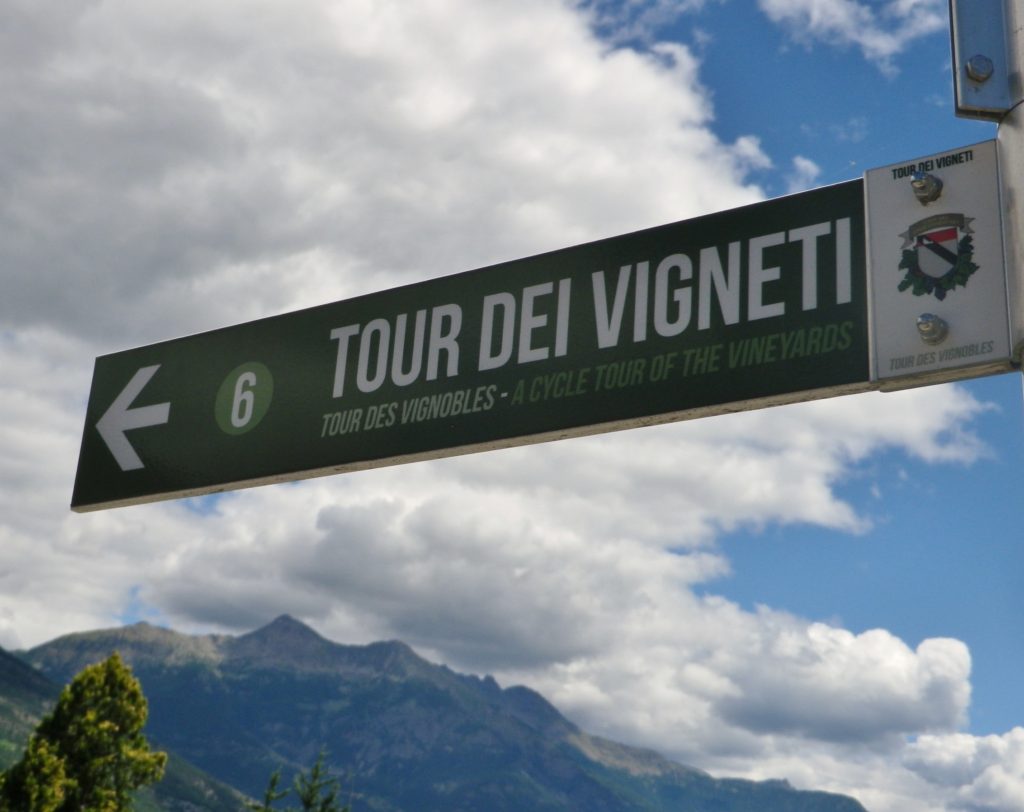
Trail Description: A series of short, one-way routes along dirt paths or little-traveled roads covering the village of Aymavilles and nearby hamlets. The numbered routes range from easy (most segments) to difficult, and may be combined according to time and/or ability, and to form circuits.
Trailhead: Cave des Onze Communes, Frazione Micheley, Aymavilles
Parking:
Aymavilles –
Small lot along SR47, just south of the Old Grizzly Café, and another lot further up the road between the roads Micheley and Urbains
In Frazione Vecellod, along street of the same name, just after the sign for the road to Aosta.
Pompoid – by the playground/sports field (basketball and soccer)
Public Transportation Options:
Bus: Societa Valdostana Autoservizi Pubblici (SVAP) Aosta-Cogne line, services Aymavilles from Aosta
Rail: No rail service to Aymavilles. (The closest rail station is in St. Pierre, about 4 kilometers distant.)
Suggested Stages:
This is a series of linked trails, branching off from one another, therefore you can choose which segments you want to do, for a total of about 10 kilometers
Trail Itinerary-Reference Points:
Aymavilles: Frazione Micheley, behind small mount and return, Frazione Pompiod; Pompiod: through village center, past soccer and basketball court, through fields; Jovencan: Frazione Adams, Frazione Pinga, Frazione Jobel, retrace partly; head to Agriturismo Mont Rosset, retrace; Pompiod: through fields and vineyards; Pompiod: retrace trail to small mount to the wine cooperative, but head south on Frazione Urbains, then Franzione Micheley around the castle; return to start.
Representative Trail Photos:
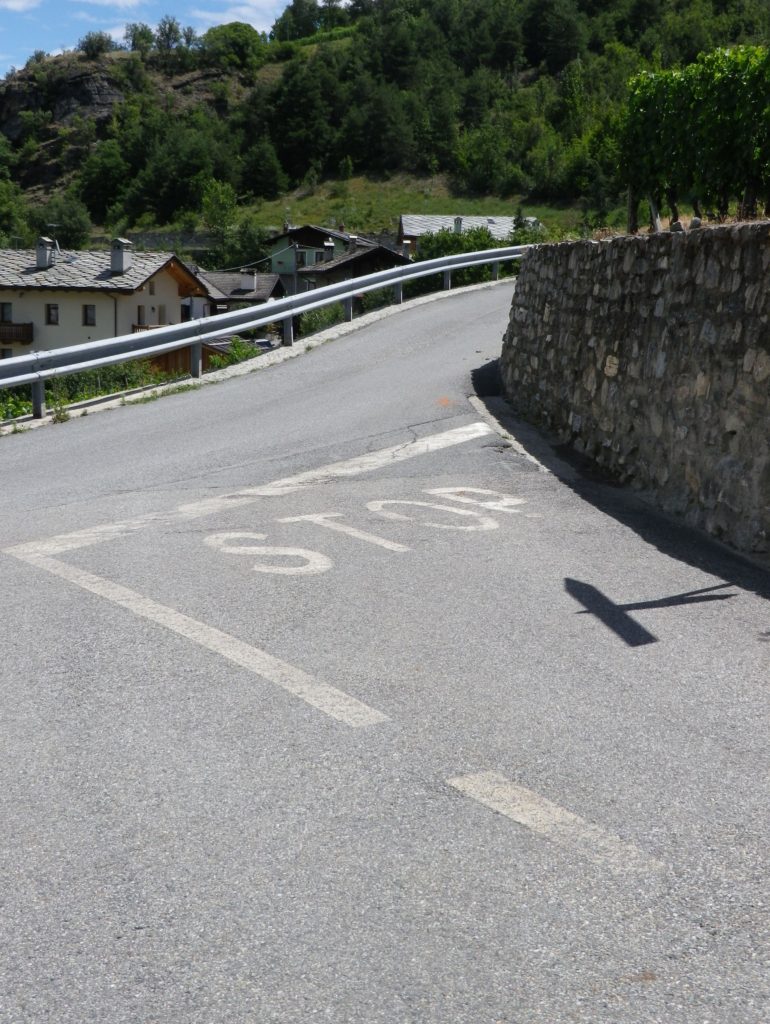
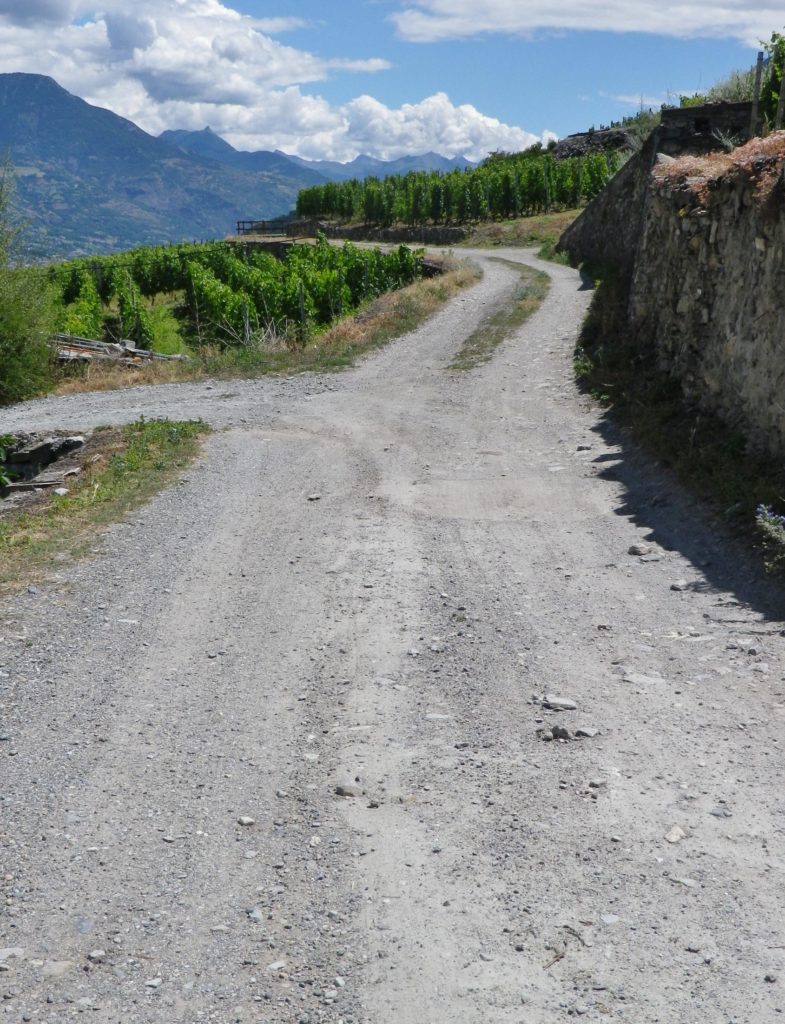
Restrooms: Aymavilles – on the lower part of SR 47 x Frazione Chef Lieu, by the church clock tower
Attractions on or near Trail:
Tasting along the Trail:
In Aymavilles, both Cave des Onze Communes and Les Cretes Viticoltori are open most days for visitors, morning and afternoon.
Alternative Options:
Hiking: Vignes et Terroirs vineyards series trails; a short circuit starts in Aymavilles.
Car: Routes de Vins Valle d’Aoste, a series of five short routes totaling about 130 kilometers, almost interlocking, covering the Aosta Valley wine producing areas.
Additional Information:
Regional: http://www.lovevda.it/en
Trail (segment) specific: http://www.caveonzecommunes.it/tour-dei-vigneti/
Comments:
The Aymavilles wine-making community designed this system of cycling itineraries for E-Bikes, which along with regular bicycles, may be rented locally. While mountain bikes are not necessary, sturdy tires are, as parts of the trail are not on asphalt! (See the photos above.)
Obviously a very short ride, but its several variations adds to its attraction. Any number of variations could prove feasible to families with tweens and teens looking for a late afternoon’s diversion; and for an early morning constitutional!
Gallery July 2020
Franconian Interlude
The Fraenkische Saale, a river flowing from near the Bavaria-Thüringen border to the Main River by Gemuenden am Main, is a jewel. Its quiet, gently flowing waters, offer low-key activities for families and friends along its shores, and on its waters, from hiking and biking to canoeing and rafting. This is an area famed for rest and relaxation, and there are several well-known spa towns along the river. From Bad Koenigshofen near its headwaters to Bad Neustadt, Bad Bocklet and Bad Kissingen, all are on the Fraenkische Saale as it heads to the Main. While the Main River is extremely well-known for its vineyards and wine, the Fraenkische Saale, connecting the wine districts of the Maindreieck and the Mainviereck, doesn’t do too badly either in that regard.
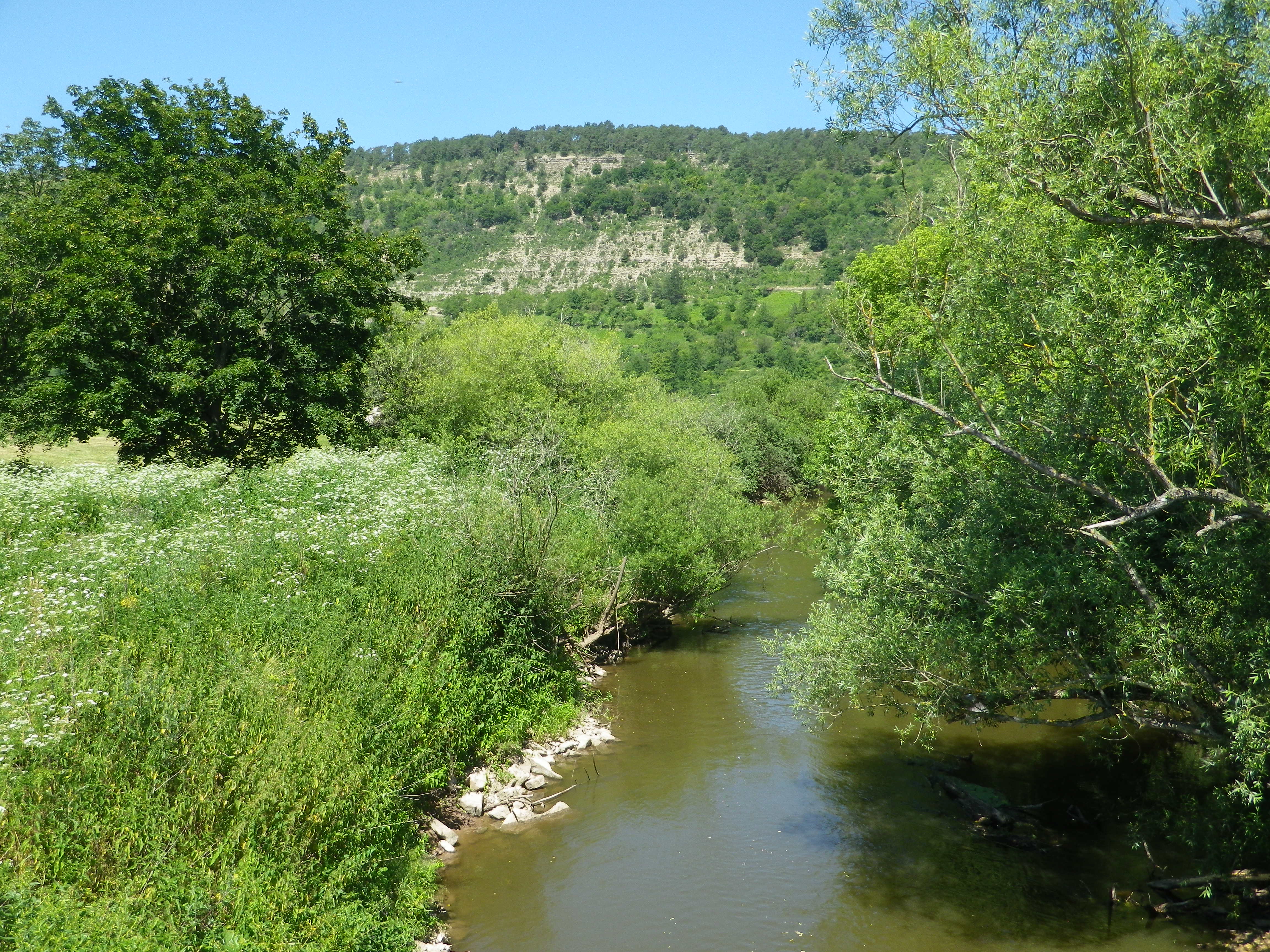
Part of the attraction for me was the opportunity to cycle along yet another river bicycle trail. Germany seems to excel in developing these trails, and the Fraenkische Saale Radweg (Bike Trail) was just another example of excellence in riverside cycling trails. The other part of the attraction for me was the chance to explore the terroir and the wines in relatively unknown wine corner of Franconia.
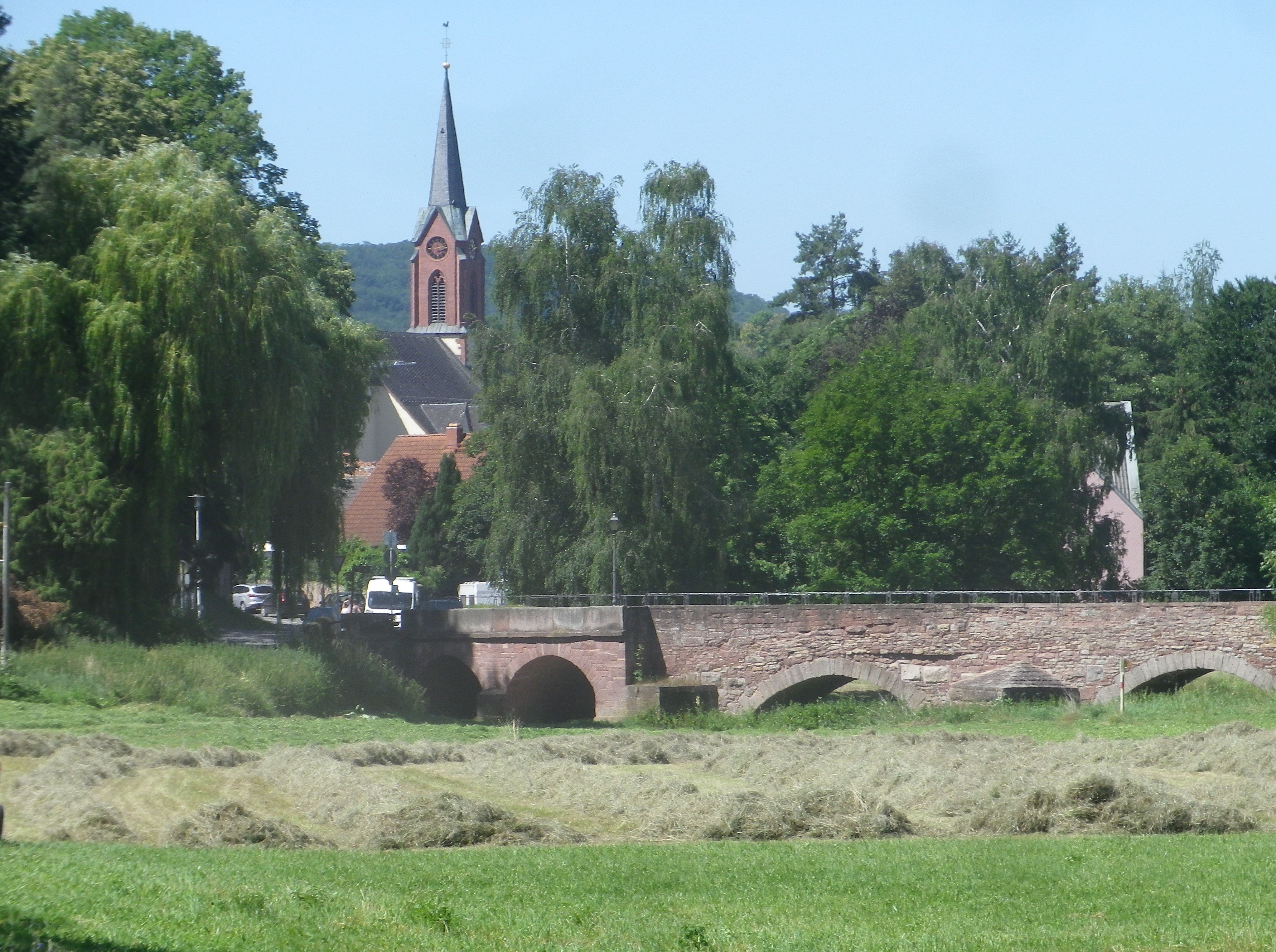
The Fraenkische Saale Radweg is about 125 kilometers, but the vineyards, Franconia’s and by extension Bavaria’s, concentrate in a short 28-kilometer-long stretch of the river and its side valleys. This made exploring them relatively easy work on a weekend. Hence, I decided to begin at Bad Kissingen, the northern and eastern-most point of my ride, one fine morning.
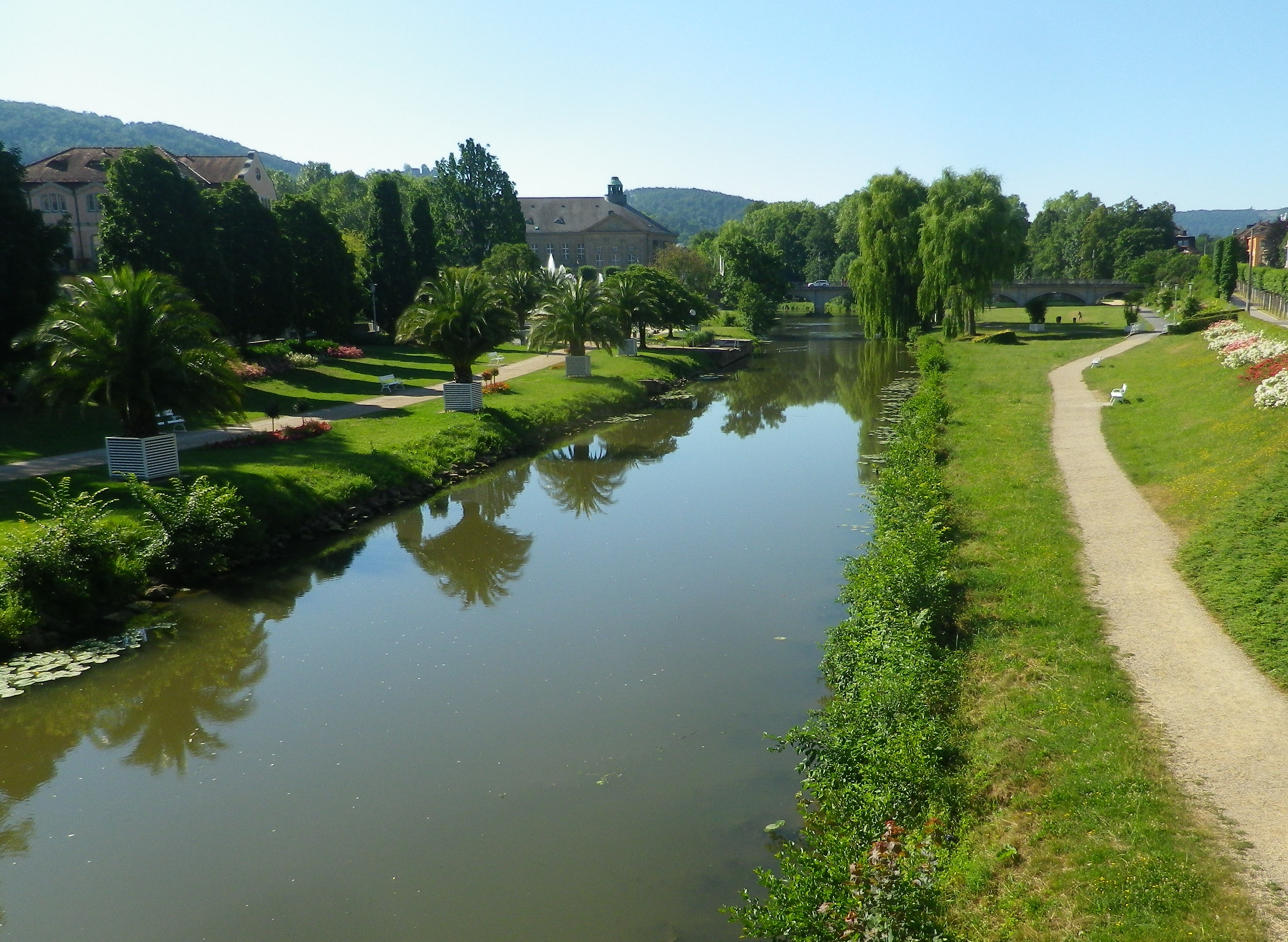
As a spa town, Bad Kissingen has a great variety of dining and lodging options to choose from. In addition, it is a lovely small town, with stately green spaces filled with curving paths along the river. The buildings are classic “German spa” and there is almost always something to attend, be it art exhibits, local festivals, or open-air concerts. I found it an excellent town to stage from, especially as the trail wove through its classic parks and gardens as it passed through town.
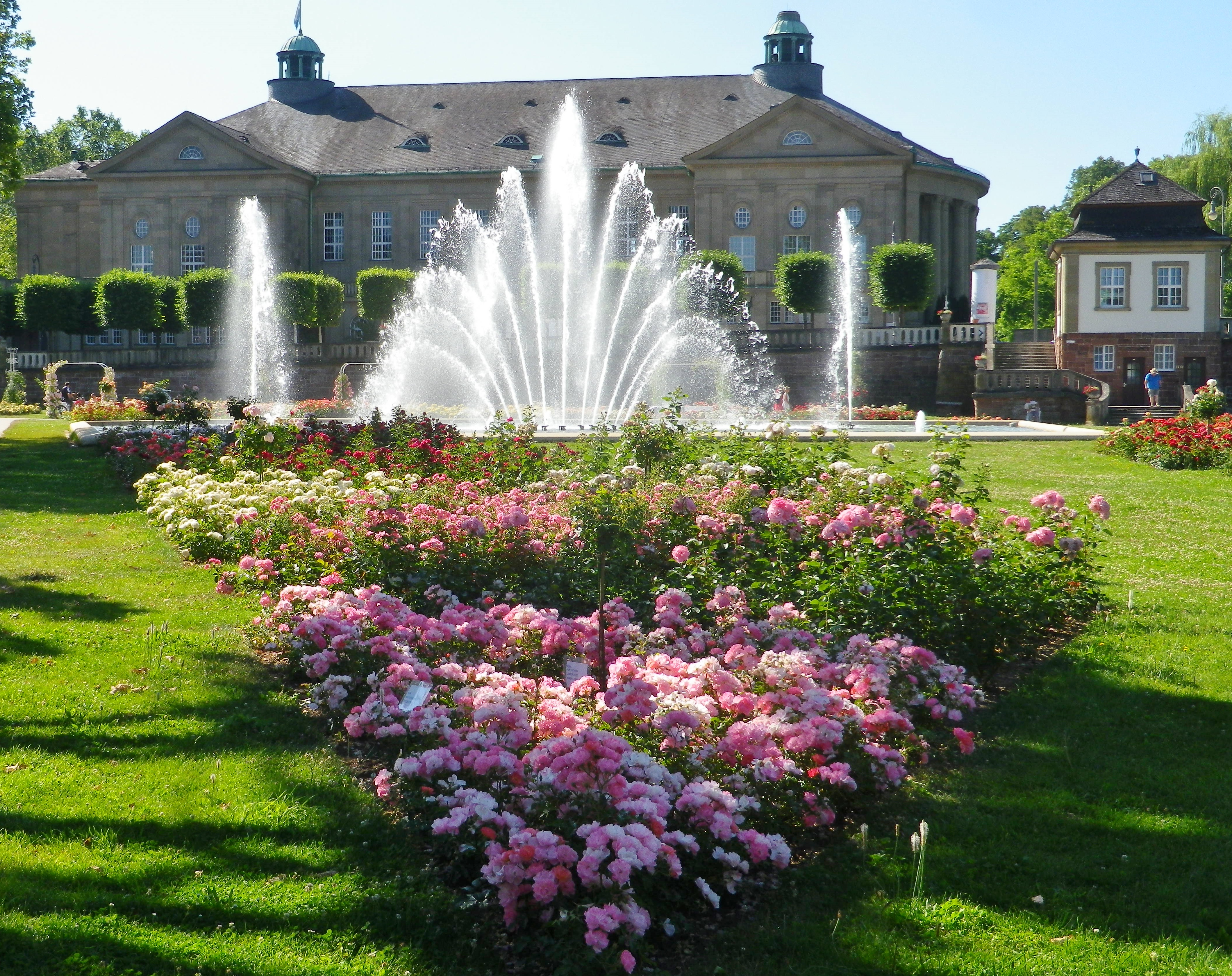
Once out of town, the trail led for a few kilometers through woods, then along fields bordering the river to Euerdorf. It proved a quiet interlude, with just nature for company. South of the Euerdorf the vineyards of Ramsthal begin.
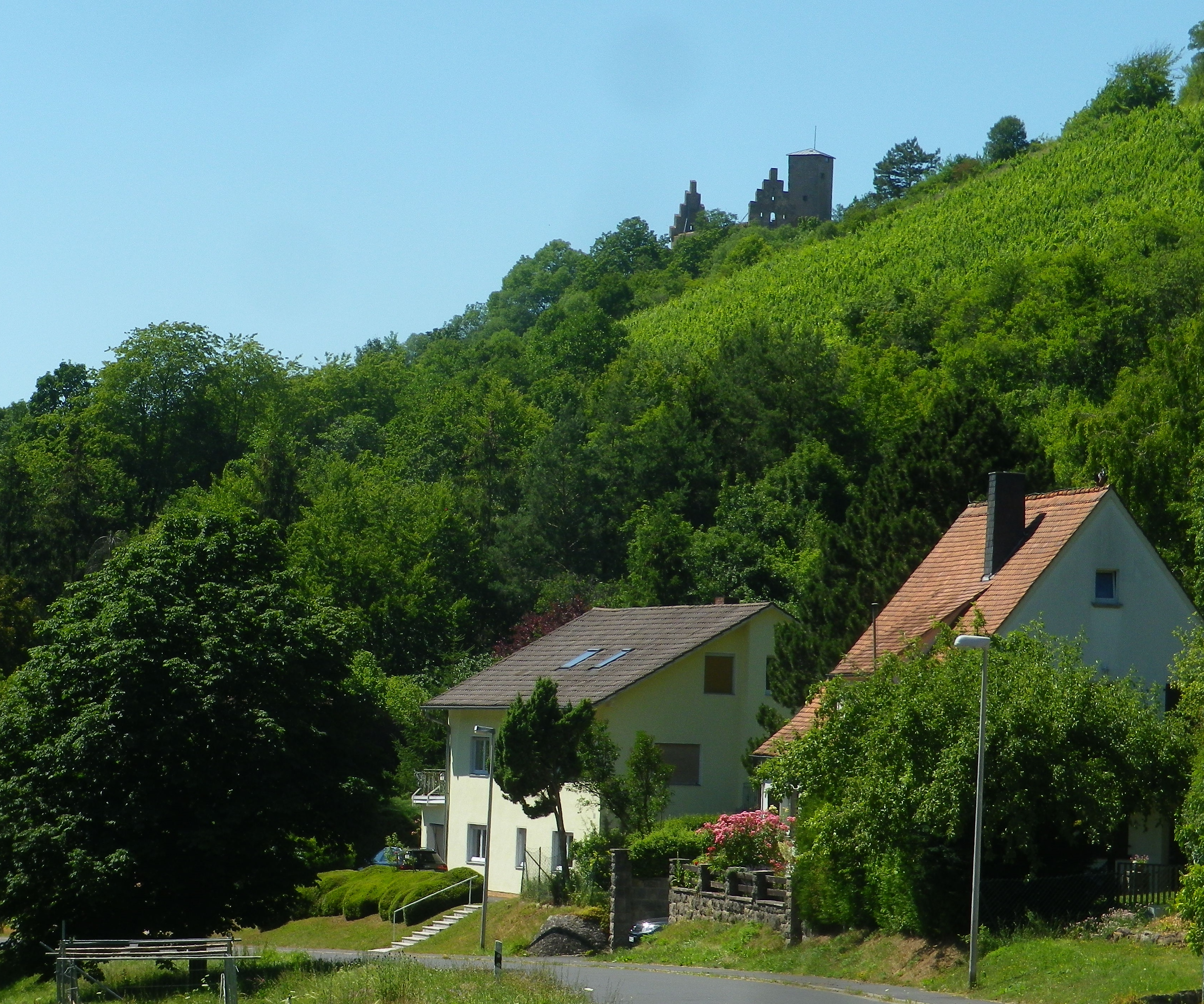
The river really does twist and turn. At Trimberg, there are more vineyards, and a castle ruin came into view. Here I crossed the river first time since leaving Bad Kissingen. But henceforth, the trail was constantly crossing the Fraenkische Saale on a series of well-maintained bridges, providing plenty of opportunities to photograph the picturesque little river. While this left me without a clear sense of where I was after so many river crossings, I was never lost, as the trail was so well marked.
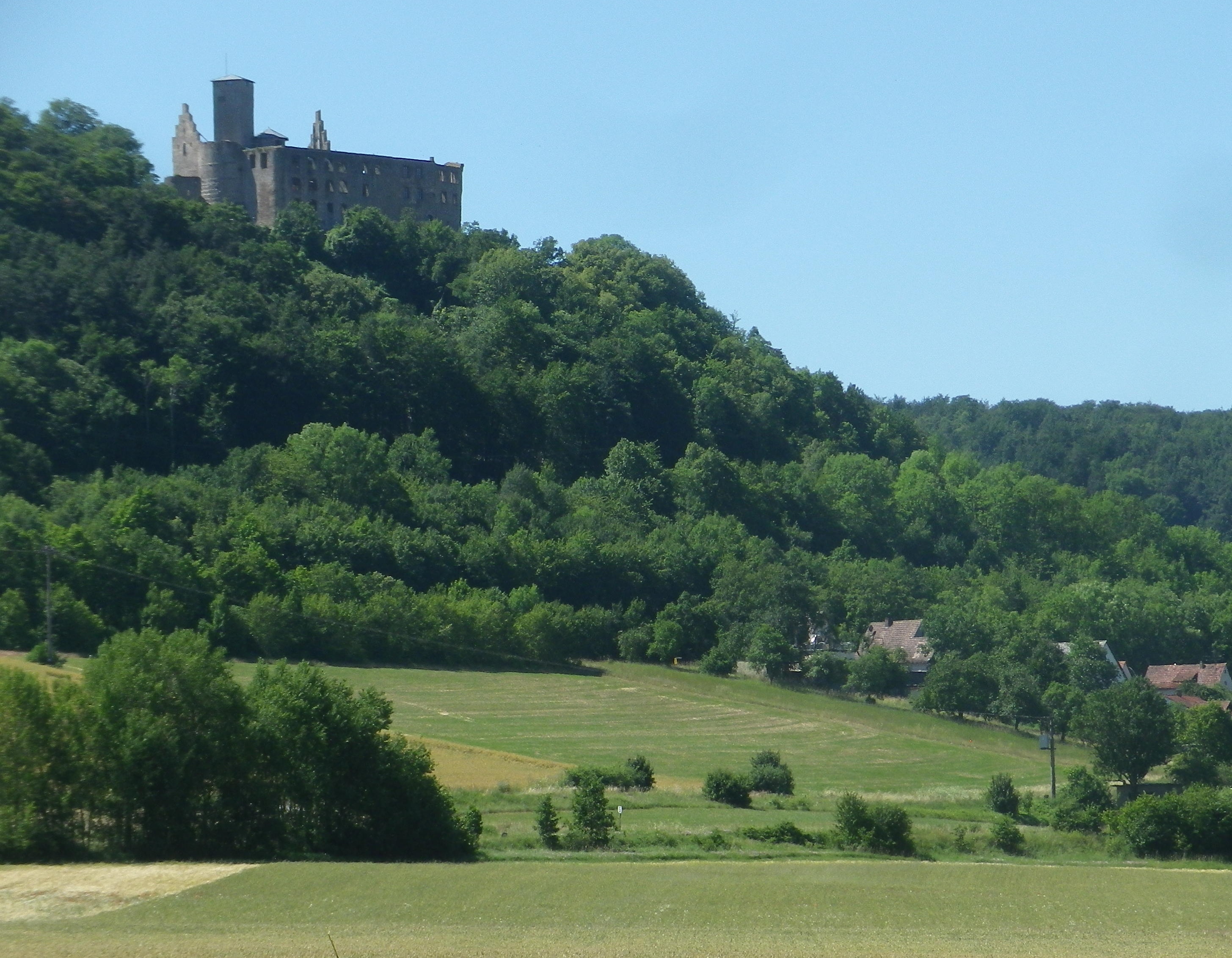
Before I knew it, I rode into Hammelburg, center for viticulture in this area. This town has a history of wine making which goes back centuries, in part due to the old abbeys. The vineyards on the hills loom over the town to the north. To the west lie the final vineyards of this wine-producing area of northern Franconia. They are in the hills above the city districts of Obereschenbach and Untereschenbach , my end destination, which was between the two sets of vineyards. While they are overseen by another picturesque castle ruin, they are not overlooked by lovers of Franconian wine!
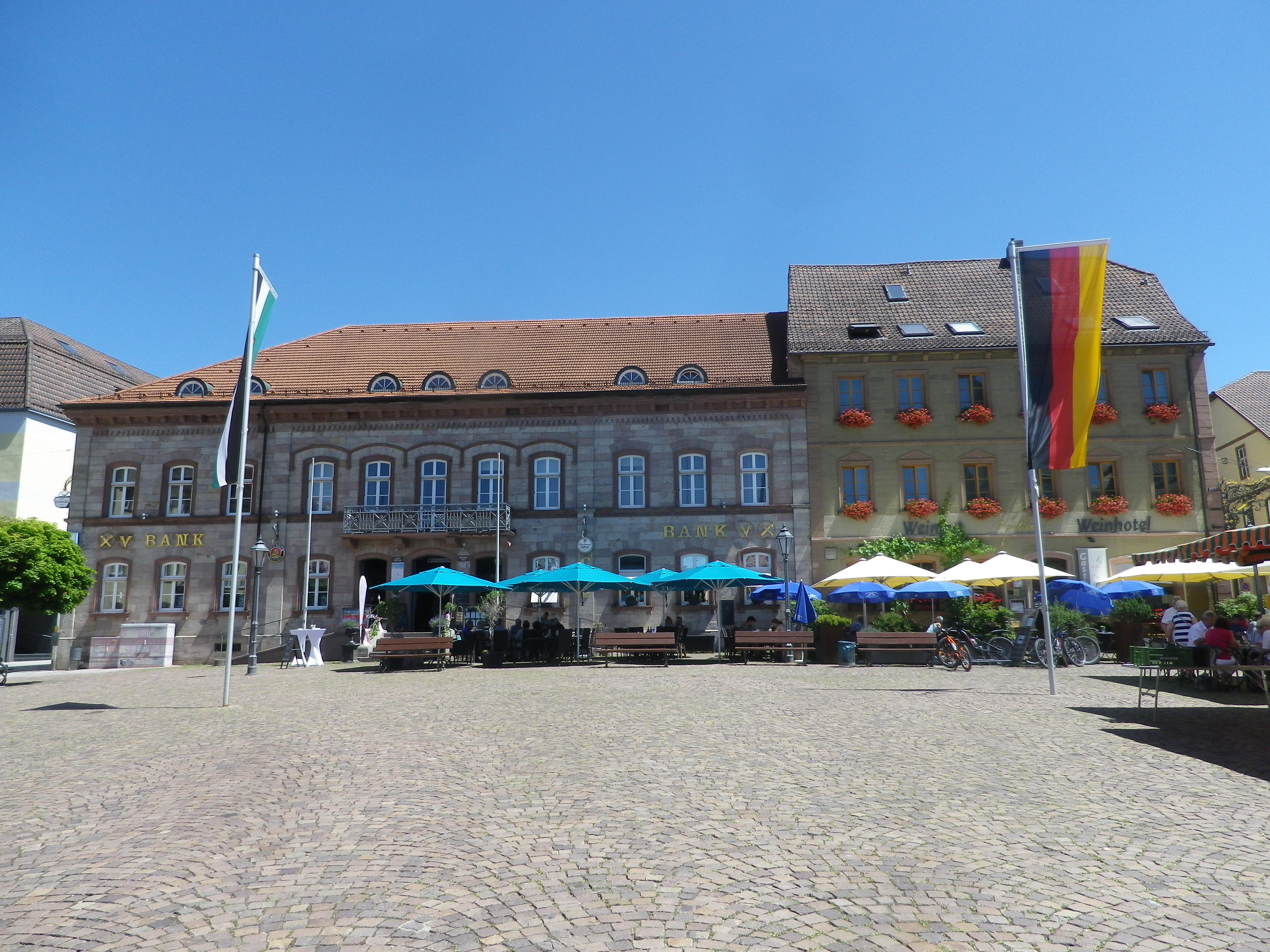
Wine Notes: Franconian Saale
What I Learned
The Maindreieck is a triangle of land surrounded on three sides by the Main River. The Main is a tributary to the Rhine. The river makes three dramatic curves close to the heart of Franconia, forming this “peninsula,” this triangle of land surrounded by the river as a paragon of viticulture in south central Germany.
While the riverine wine towns and villages form the most well-defined area of the Maindreieck wine district, i.e., Wuerzburg, Randersacker, Sommerhausen, Volkach, there are two lesser known wine-producing areas in this district. Both of them follow along valleys with smaller rivers, the Wern and the Fraenkische Saale. These two are tributaries entering the Main River at Schweinfurt and Gmuenden am Main respectively.
Bavaria’s northern most vineyards lie along the Fraenkische Saale – a river flowing from close to the Bavaria – Thuringen border to the Main by Gemuenden am Main. In wine speak, that would be from the Maindreieck border to the Mainviereck border in the Franconian Wine Region.
The wines produced along the Fraenkische Saale and its tributaries are the northern-most wine-producing area in Franconian Bavaria. The town of Hammelburg is known as Franconia’s oldest wine town. In 777, Charlemagne, who held a small fortress settlement on this site, donated the site and its lands to the Abbey of Fulda, some 40 miles north. Wine production for the abbey, founded about 30 years earlier, used the south facing, limestone-based slopes, overlooking the Fraenkische Saale, to grow grapes for wine. Over time, grapes also grew in neighboring settlements, and up side valleys. The Abbey built a cellar-palace, which the abbot used as a summer residence. At its height in the 18th century, the cellar stored almost three-quarters of a million liters of wine. Today the complex belongs to the major Franconian cooperative GWF. However, there are also a dozen or so independent wineries. Overall, about 70 local farmers/viticulturists grow grapes for local wine production.
The major Franconian grape varietals grow in this sub-district. Not surprisingly, they are the hardy, cold-resistant varietals. listed below.
Silvaner: This varietal has been grown in the Franconia area since the 17th century, and is one of the more important varietals for this particular area. Many locals prefer it over Riesling. For more information on Silvaner, see Wine Notes: Franconia’s Silvaner here.
Mueller-Thurgau: This hybrid varietal is also known as Rivaner, and produces a light, fruity wine. In Franconia, it is currently more widely planted than Silvaner.
Riesling: Riesling wine is the most planted varietal in Germany, but less so in Franconia. Here, true to form, many Riesling wines take on a mineral flavor determined by the soil.
Bacchus, a Silvaner-Riesling cross with a Mueller Thurgau, has only been around as a wine for about 50 years, and has been especially successful in Franconia.
What I Tasted
2018 Bacchus, Halbtrocken, Q.b.A., Weingut Mueller (Hammelburg): An off-dry white wine with a medium golden gold color; a fruity nose, with citrus and hints of gooseberry, and with gooseberry, apricot, and slight lemon flavors; medium minus acidity, with a smooth finish.
2018 Silvaner, Trocken, Qualitaetswein, Weingut Neder (Ramsthal): A dry white wine with medium plus gold color; a nose of spice and green apple, with spice, green apple, citrus and slight floral flavors; medium acidity with a refreshing tart finish
2017 Silvaner, Hammelburger Heroldsberg, Trocken, Kabinett, Weingut Mueller: A dry white wine with medium lemon-yellow color; a slightly spicy nose, with green apple, spice and slight honey flavors; medium plus acidity with a tart medium length finish.
2017 Silvaner, Hammelburger Heroldsberg, Trocken, Kabinett, Weingut Mueller: A dry white wine with medium gold color; green apple and floral nose, with flavors of the same; medium acidity, with a tart finish.
